50 Must Visit Temples in South India
Unlike the Hindu shrines in other parts of India, what makes the temples in South India unique is their grand structure, done beautifully in Vijaya Nagara and Dravidian architectural styles. In the southern part of the country, you will find numerous temples with absolutely stunning works of art, all dedicated to the different gods as a form of devotion and prayer, making these Hindu temples places where a plethora of devotees throng from the world over. Each shrine in South India, irrespective of its location displays fine artwork not only in the interiors but also on its tall and intricately worked upon Gopurams.
For instance, the exquisite decor of the popular Sabarimala Sastha Temple in Sabarimala is simply breathtaking, or the colorful facade of Meenakshi Temple in Madurai, which is simply divine! The richness of South India temples does not limit itself to just the architecture but is absolutely filled with spirituality and devotion where millions of devotees gather to pay respect to the holy figures. You can expect to witness the interesting rituals like hair offering or tonsuring to Lord Venkateswara, or performing a ritualistic dance at certain temples in the region.
We can surely say that, there is no shortage of temples to tour in the South Indian states where you can visit to revitalize your soul and spirit with the blessings of the gods. We have compiled a list of 50 must visit temples in South India that will help you make your pilgrimage travel to this part of the country even better.
Popular Must-Visit Temples in Kerala, South India
- Vadakkunnathan Temple
- Aranmula Parthasarathy Temple
- Sree Padmanabhaswamy Temple
- Sabarimala Sastha Temple
- Attukal Bhagavathy Temple
- Sree Krishna Temple
- Thirunelli Temple
- Sivagiri Mutt
- Vaikom Mahadeva Temple
- Sree Vallabha Temple
Vadakkunnathan Temple: A classically built temple of Lord Shiva and the ancient artworks of Thrissur
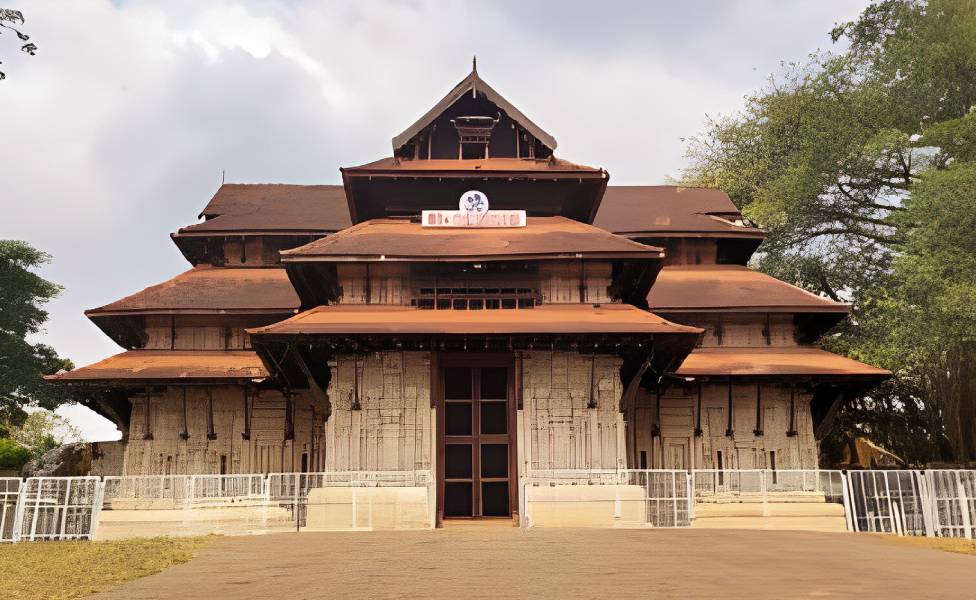
The Vadakkunnathan Temple in Thrissur is a temple dedicated to the worship of Lord Shiva. Been in existence for centuries, the temple is built in the classical style of Kerala architecture with four gopurams or towers on each side of the structure. When visiting Thrissur, this temple is a place that you must visit. Set amid the lush garden, the temple is located in the center of the town. Here, you can explore the exquisite collection of artworks and mural paintings that display the episodes from the puranas.
Apart from the idol of Lord Shiva, the temple also houses idols of Goddess Parvati, Lord Ganesha, Lord Shankaranarayana, and Lord Rama. In the outer temple area of the Vadakkunnathan Temple, there are also shrines dedicated to Lord Krishna, Nandikeshwara, Parasurama, Simhodara, Ayyappa (Sastha), and Sankaracharya. This temple in Thrissur is a popular one and is most visited by devotees during its annual celebration of the Thrissur Pooram Festival, organized at a grand scale. The festival sees a majestic display of elephants who stand adorning fancy caparisons and parasols and are one of the highlights of the occasion. Thrissur Pooram also witnesses the sounds of traditional percussion instruments and a beautiful display of fireworks.
- Main Deity: Lord Shiva
- Place: Thrissur
- Highlight: Pooram Festival celebrated in the months of April and May.
Also Read: Thrissur Travel Guide
Aranmula Parthasarathy Temple: Get engulfed by the grandiose temple of Lord Krishna in Aranmula
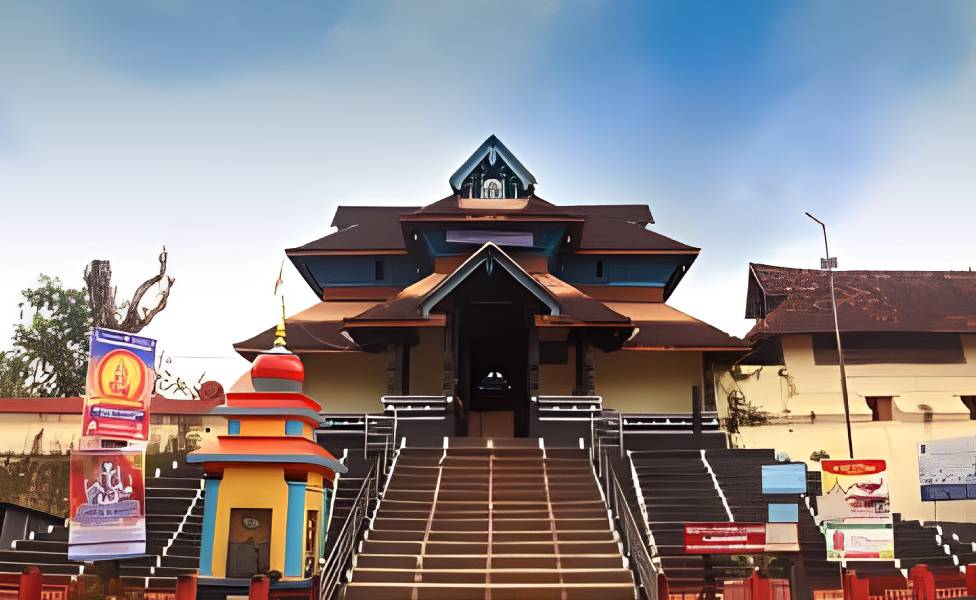
The Aranmula Parthasarathy Temple in Kerala is one of its must-visit temples, dedicated to Lord Krishna, the eighth incarnation of Lord Vishnu. Here, you’ll find that Lord Krishna is referred to as Parthasarathy which is so because of his role in the epic tale of Mahabharata. As per the legend, the Aranmula Parthasarathy Temple gets its name for the fact that the idol inside the temple was brought here in a raft made up of six pieces of bamboo, where “Aru” means six and “Mula” means bamboo. Built along the Pamba River, the temple is located in the Pathanamthitta district of Kerala.
Apart from adoring the architecture of the temple, you can also attend the Valla Sadya, and witness the traditional snake boat race that takes place in the Pamba River during the festival of Onam. The temple is built in the traditional style of Kerala architecture and features beautiful wooden carvings all along the temple that depict tales from the Hindu epics of Mahabharata and Ramayana. Today, the temple also focuses on preserving the state’s culture by conducting classes for classical music, dance, and Kerala’s traditional martial arts, the Kalaripayattu.
- Main Deity: Lord Krishna (incarnation of Vishnu)
- Place: Aranmula
- Highlight: Valla Sadya is held at Aranmula in Parthasarathy Temple during Ashtami Rohini (Krishna Janmashtami) in the month of September.
Sree Padmanabhaswamy Temple: Be amazed unraveling the story of the temple and its six hidden vaults
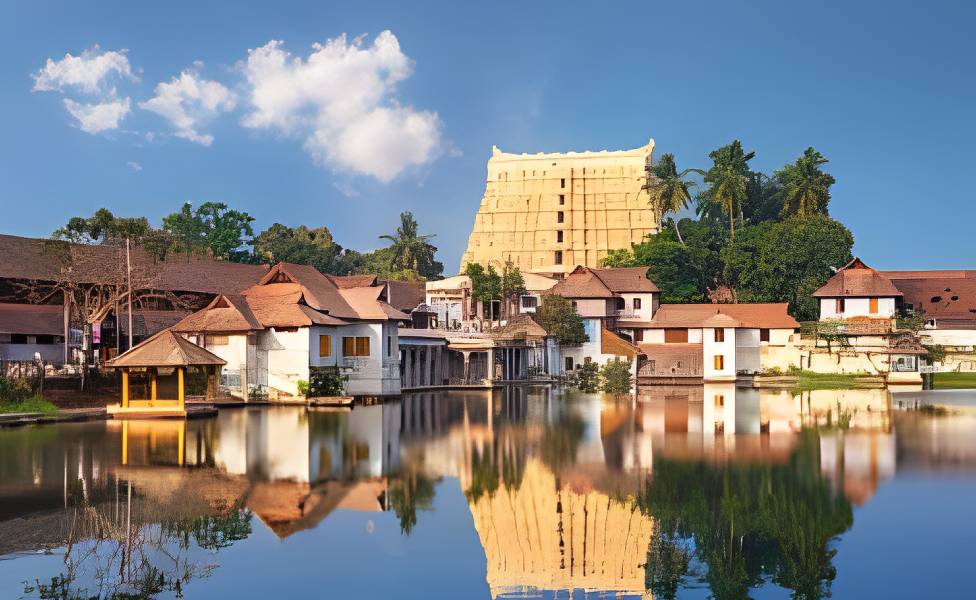
Sree Padmanabhaswamy Temple at Kerala is another temple that has been in existence for ages, going back as far as the 8th century. The temple is one of the most popular Hindu temples in the region and is said to be the richest temple in the world. Built in a Dravidian style of temple architecture, the temple’s gopuram is seven storeys tall and has seven golden domes on the top, meant to represent the seven worlds.
Apart from its beauty, what captivates people most about the temple is the legendary stories attached to it. The temple has six underground vaults which have been marked as A, B, C, D, E, and F. Out of these, only five vaults have been opened till date from which precious items of gold, and gems were discovered. The only vault which hasn’t been opened is vault B, considered to be highly mysterious and is warned not to be opened by any human force, which according to the temple authorities is not auspicious and may bring ruin. What lies behind vault B continues to remain a mystery, with opinions ranging from snakes, supernatural entities, and an option where it is said to open directly into the Arabian Sea, bringing catastrophe with it if opened.
- Main Deity: Lord Vishnu
- Place: Trivandrum
- Highlight: Padmanabhaswamy Temple is known for having a mysterious door that no one can open. The two festivals of Alpashy (October/November) and Panguni (March/April)
Also Read: Must Visit Places in Kerala
Sabarimala Temple: Let your senses be spiritually awakened in South
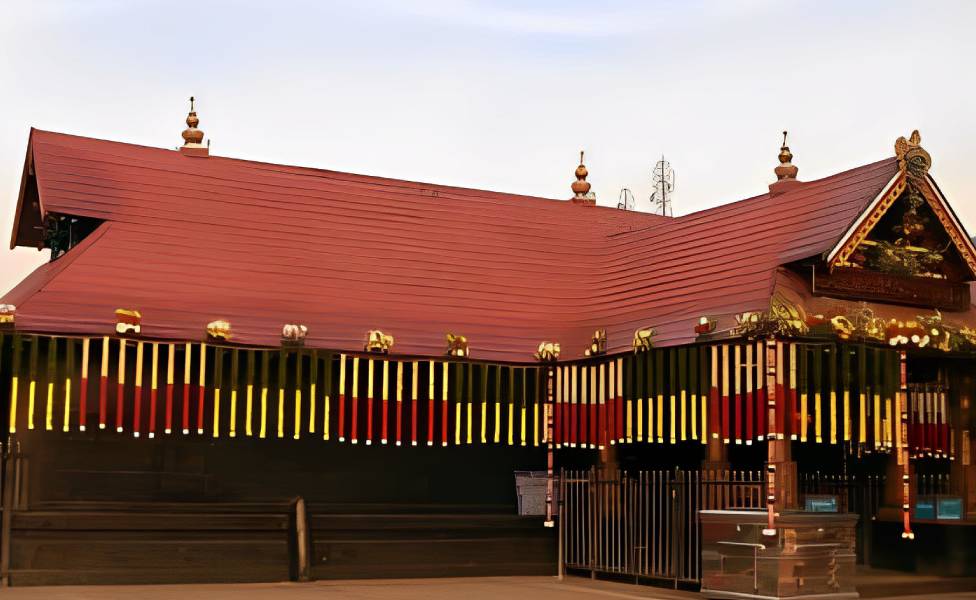
Sabarimala Sastha Temple of the Sabarimala Sree Dharma Sastha Temple is one of the more popular temples in the region and is dedicated to Lord Ayappa, a prominent deity of southern India. Every year crowds of devotees take up a pilgrimage to the temple and to immerse themselves in the spirituality of the temple. Entry to the temple is only restricted to men, girls who have not attained puberty, and post-menopausal women.
The temple is located on a hilltop at a height of 3,000 ft. in the Pathanamthitta district of Kerala and allows visitors from all religions. Though, for visiting the temple, it is required that devotees sanctify themselves by practicing celibacy for a period of 41 days prior to the visit. Located in the blissful surrounding of the Periyar Tiger Reserve, visitors come here to witness and be a part of the mass pilgrimage performed. It is said that this temple receives around 30 million pilgrims annually. The pilgrimage season starts from November to mid-January with the Mandala Pooja and Makaravilakku being the main events with the temple remaining closed for the rest of the year except on the first five days of every month of the Malayalam calendar and on the festival of Vishu.
- Main Deity: Lord Ayyappa
- Place: Sabarimala, Pathanamthitta District
- Highlight: It hosts one of the largest annual pilgrimages in the world with devotees coming from the nearby southern Indian states
Also Read: Top Places to Visit in Munnar Kerala
Attukal Bhagavathy Temple: Admire the meld of Tamil and Kerala style architecture in Trivandrum
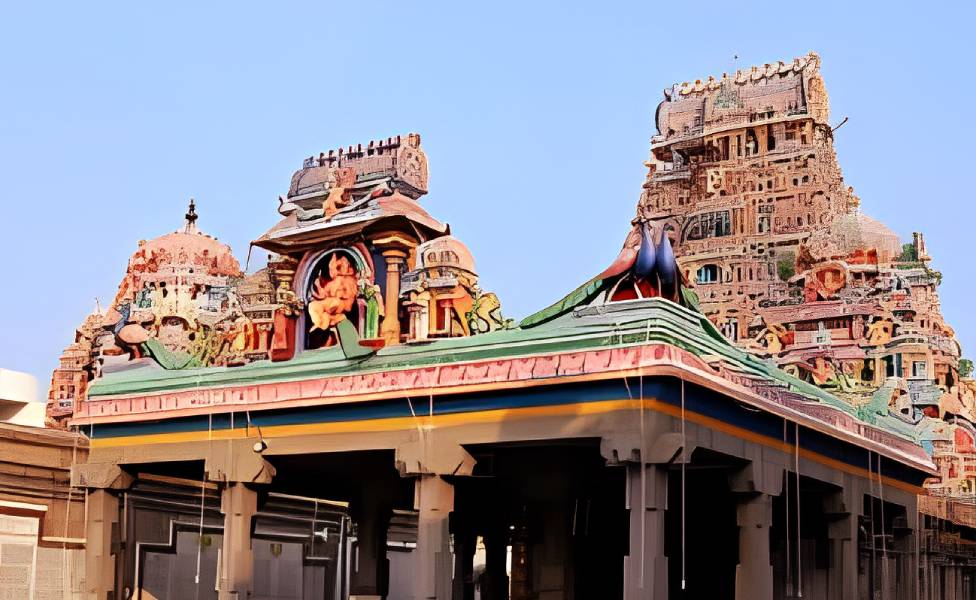
Displaying an authentic blend of both Kerala and Tamil architectural wonder, this colorful temple of Attukal Bhagavathy is yet another famous place of worship in the state of Kerala. While the interiors house the most attractive sight, the idol of the Goddess Bhadra Kali, the deity of the temple sits completely adorned with gold ornaments with the exteriors of the temple all carved with beautiful sculptures that cover the temple, making it stand out beautifully.
Goddess Bhadrakali worshiped at the temple is known for being both, a creator as well as destroyer of life and is considered in high reverence by the devotees. The Attukal Bhagavathy Temple is also known as the Sabarimala of Women since it is women that form the major number of devotees. The temple sees the most crowds during the festival of Pongala, where women come to celebrate the festival from different parts of Kerala and Tamil Nadu. The festival is a 10 day affair with the celebration involving cooking the Pongala in the premises of the temple under the open air. The Pongala celebrations at the temple are held at a grand scale, with it even being recorded in the Guinness Book of World Records for being the largest annual gathering of women in the world.
- Main Deity: Goddess Bhadrakali (Kannaki)
- Place: Trivandrum
- Highlight: The annual 10-day Attukal Pongala Festival is held between Feb to March and it also holds a Guinness Book of World Records for having the largest gathering of women.
Also Read: Top Hill Stations to Visit in Kerala
Sree Krishna Temple: Pray and seek blessings of one of the oldest idols of Lord Vishnu in Guruvayoor
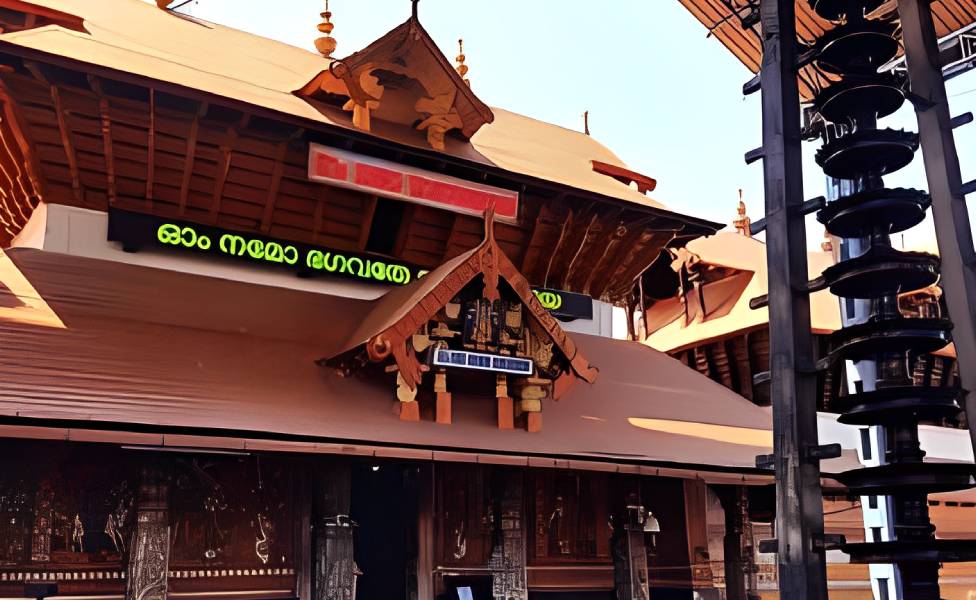
Also referred to as the “Dwarka of the South”, the Sree Krishna Temple in Guruvayoor is one of the most visited Krishna temples in the whole of Kerala attracting devotees from across the country for its marvelous architecture and rich history. Situated in the Thrissur district of the state, the temple is dedicated to the worship of Lord Krishna and Lord Vishnu. Lord Krishna at the temple is worshiped as Lord Guruvayurappan, a form of his with four arms. One arm holds a conch, another holds the Sudarshana Chakra, Kaumodaki in the third arm, and the last one holding a lotus.
The Sree Krishna Temple is built in the Dravidian style of architecture and portrays a beautiful blend of the traditional architectural style of Kerala. The centuries-old temple stands adorned with multiple murals belonging to as far as the 17th century, making visiting the temple a truly magical experience. One of the ceremonies, the Thulabharam is a popular offering at the temple, where devotees present offerings of bananas, jaggery, and coconut equivalent to their weight by getting weighed on a giant scale and offering it to the temple with the most auspicious time to visit the Sree Krishna Temple during the festival of Janmashtami, on the occasion of the birth of Lord Krishna.
- Main Deity: Lord Vishnu (Worshiped in the form of Guruvayurappan)
- Place: Guruvayoor
- Highlight: In the vicinity of the temple, there is a pond/tank where it is believed Lord Shiva and his family worshiped Vishnu and is therefore considered to be sacred.
Also Read: Top Things to Do in Wayanad
Thirunelli Temple: Seat yourself in the lap of religious affair in Wayanad amid calm settings in Brahmagiri Hills
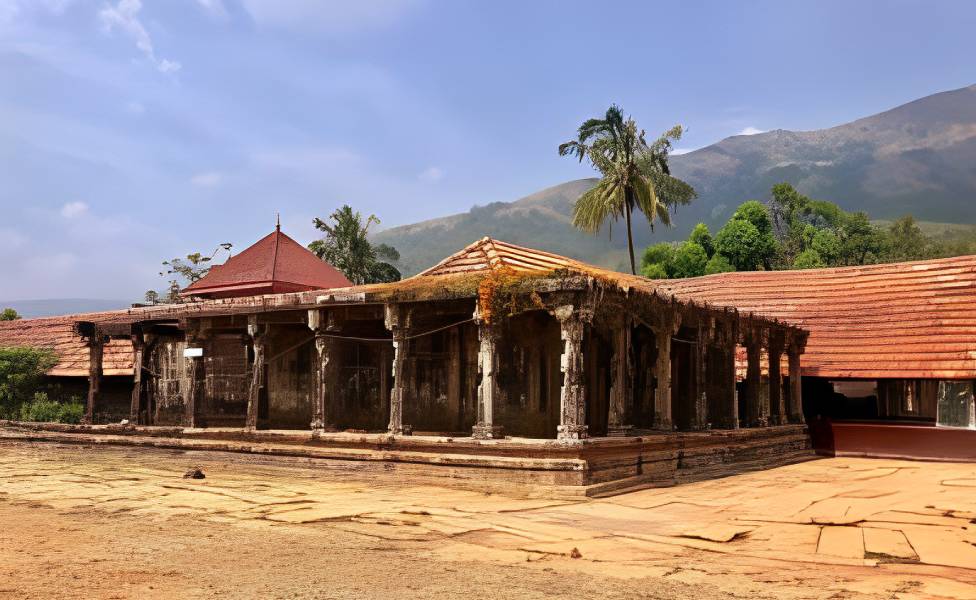
Surrounded by the Brahmagiri hills and a shimmering nearby holy stream of Papanasini, Thirunelli Temple is one of the most popular religious sites amongst the Hindu followers in Kerala. Linked with legends and folklore, the temple’s primary deity is Lord Vishnu. Offering a beautiful display of Kerala’s traditional architecture, the Thirunelli Temple is adorned with intricately carved pillars that further add to its beauty. The mesmerizing Thirunelli Temple is also called the “Sahyamala Kshetram” and is often lovingly referred to as the “Kashi of the South”.
According to the legend surrounding the temple, it is said to have been built by Lord Brahma himself. The beauty of the Brahmagiri Hills is what made Lord Brahma descend to the region, upon which he saw an idol of Lord Vishnu lying under an amla tree (nelli in malayalam) with which he established a temple at the spot. The nelli or the amla tree is what is said to give the temple its name. The temple is popular with devotees who come here to perform ancestral rites and rituals, which are performed at the banks of the Papanasini stream, located near the temple. The Thirunelli Temple and its surrounding village is also a favored place for trekkers given its scenic beauty and high terrain.
- Main Deity: Lord Vishnu
- Place: Wayanad Valley
- Highlight: The holy temple pond, Panchatheertham and the holy stream, Papanasini where pilgrims bathe to eradicate evil.
Also Read: Best Places to Visit in Kovalam
Sivagiri Mutt: Explore the multi-tiered temple dedicated to Goddess Saraswati in Varkala
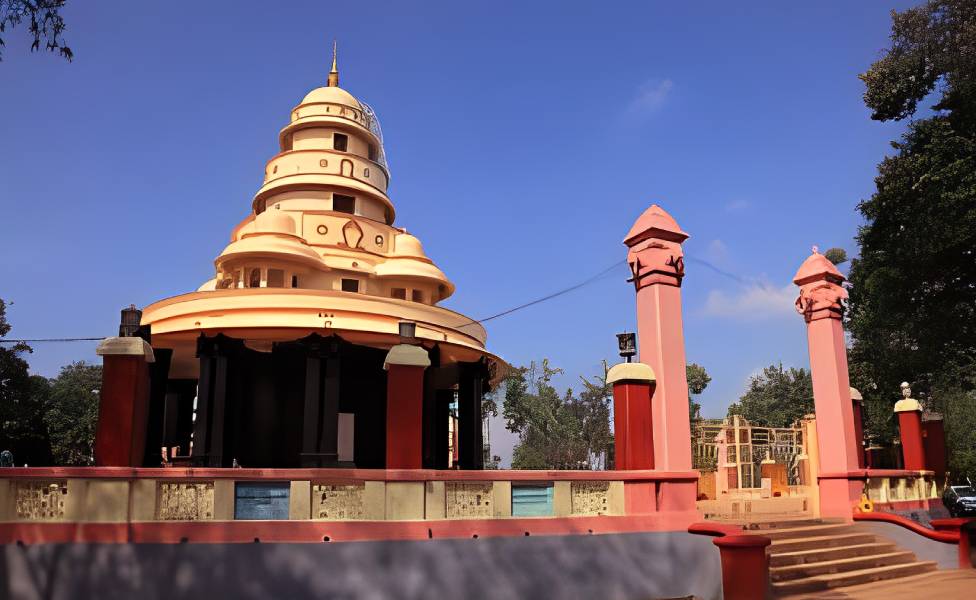
At a close distance from the main town of Varkala, you can spot the Sivagiri Mutt which is one of the popular pilgrimage sites in Kerala. This pilgrimage center is noted to be not only a holy destination in Kerala but it also serves as the headquarters to Sree Narayana Dharma Sangham, established by the social reformer and philosopher, Sree Narayan Guru. The multi-tiered mutt is white in color and stands out from other temples of the region. The Sivagiri Mutt is also the final resting place of Sree Narayana Guru and also displays his residence and personal belongings, attracting a number of tourists to the place.
The Sivagiri Sarada Temple of Sivagiri Mutt is a temple dedicated to Goddess Saraswati, the goddess of knowledge, wisdom, and learning. The temple is white in color and is octagonal in shape with white walls and multiple windows, a design uncharacteristic of temples. The four-armed goddess in the temple sits atop a lotus flower, with one arm carrying a bird, a book in another, a pot full of nectar in the third arm, and the fourth arm performing the chin mudra pose. The Sivagiri Temple sees the most crowd during the annual pilgrimage that is performed between December 30 and January 1.
- Main Deity: Goddess Saraswati
- Place: Varkala
- Highlight: The Sivagiri temple enshrines Sree Narayana Guru’s tomb and hosts the annual celebration of Sri Narayana Jayanthi during Aug/Sep.
Also Read: Best Places to Visit in Kumarakom
Vaikom Mahadeva Temple: Go for a spiritual tour in the most revered temple in Kerala in Varkala
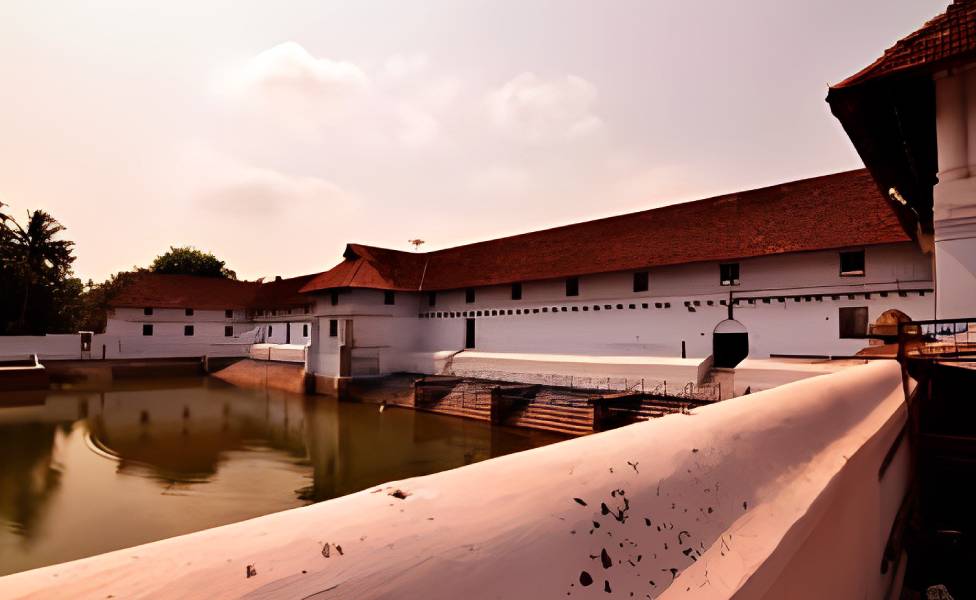
Vaikom Mahadeva Temple along with Ettumanoor Shiva Temple and Kaduthuruthy Thaliyil Mahadeva Temple situated in the Kottayam district of Kerala form the most powerful triad of Shiva temples in the region. It is said that, if you seek blessing in these three temples before Ucha pooja, your wishes may come true. Located in Vaikom, this revered temple is respected by both the Shaivites and the Vaishnavites but worships the primary deity as Lord Shiva.
An ancient temple, the Vaikom Mahadeva Temple is considered one of the oldest temples in Kerala, with the Shiva Linga in the temple said to date back to the time of the Treta Yuga and is the only temple in Kerala with an oval-shaped Sreekovil or Garbhagriha. The beautiful ancient temple of Lord Shiva is constructed majorly out of stone and displays amazing craftsmanship. At Vaikom, Lord Shiva is lovingly referred to as “Vaikathappan” or “The Lord of Vaikom”.
- Main Deity: Lord Shiva
- Place: Vaikom
- Highlight: Vaikom Ashtami is the most auspicious festival held during Nov/Dec. The Shivling erected here is believed to be one of the oldest in Kerala.
Also Read: Interesting Facts About Sabrimala Temple
Sree Vallabha Temple: Delve into a full day of mural exploration in the temple of Lord Sreevallabhan in Thiruvalla
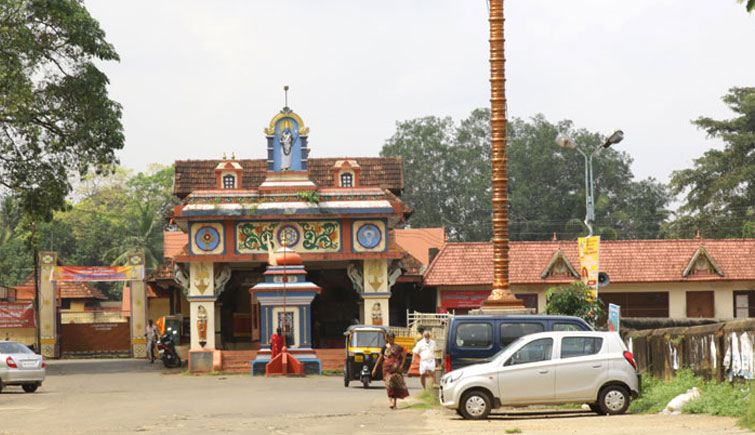
One of the biggest temples in Kerala, Thiruvalla Temple is famed for its architectural grandeur that boasts of an exquisite collection of beautiful murals inside the temple and intricate design stone-wooden carvings. Dedicated to the worship of Lord Vishnu as Sree Vallabhan, this temple is located in Thiruvalla, in the Pathanamthitta district of Kerala and dates back to as far as 400 years. The temple lies along the banks of the River Manimala and has a flag mast that is 54 ft tall built by a legendary Perunthachan using a single block of granite.
Constructed in the traditional Kerala style, the Sree Vallabha Temple has four gopurams, each facing a different direction. The Sreekovil or the garbhagriha of the temple is circular in shape and houses the idol of Sree Vallabha facing in the east direction and the idol of Lord Sudarshana facing west. Apart from them, there are eight other deities worshiped in this temple such as Varadakshinamoorthy, Vadakkum Thevar, Ganapathy, Garuda, Sastha, Kurayappan Swami, Ayal Yakshi, and Maya Yakshi. It is believed that Lord Vallabha really likes Kathakali, due to which it is performed almost all days at the temple as an offering by the devotees to please the Lord.
- Main Deity: Lord Vishnu
- Place: Thiruvalla
- Highlight: Thiru Utsavam (Feb/March) and Uthira Sreebali (March/April) are two auspicious festivals celebrated here.
Other Interesting Blogs to Read
Must Explore Temples in Karnataka, Southern India
- Mahabaleshwar Temple
- Durga Temple
- Bhutanatha Temples
- Sri Krishna Temple
- Annapoorneshwari Temple
- Veera Narayana Temple
- Kukke Subramanya Temple
- Lakshminarayana Temple
- Murudeshwara Temple
- Kollur Mookambika Temple
Mahabaleshwar Temple: Explore the ancient temple of Lord Shiva of classical architectural style of the South
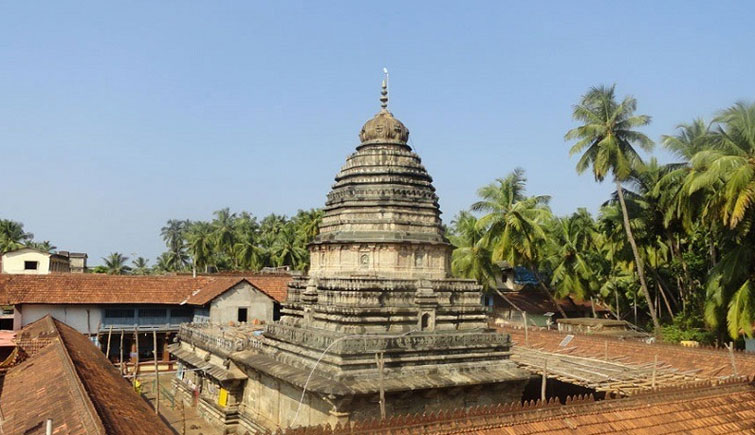
Completely built in a classical Dravidian style of architecture, Mahabaleshwar Temple is located on the shores of the Arabian Sea in Gokarna in worship of Lord Shiva. What makes this temple one of the most sacred pilgrimage attractions in Karnataka is for the legendary stories that unfold the history of its gods. One of them being where Ravana, who was given the Atmalinga by Lord Shiva was forced to place it on the ground at Gokarna, which he was hesitant about since the Atmalinga once on the ground could not be picked up by anyone. And so, once the Atmalinga was placed at the site, he was unable to pick it up, leading the temple to be constructed in worship of Lord Shiva.
The Atmalinga at the temple is 6 ft. long and is worshiped ardently by the devotees. It is during the festival of Ashta Bandana Kumbhabhishekam that happens every 40 years that the Atmalinga is shown to the devotees in its entirety, which remains hidden from them majorly otherwise. The Mahabaleshwar Temple, along with the Atmalinga also has a stone carved idol of Lord Shiva, said to date back to 1,500 years! Due to its importance, and holiness, this temple in Karnataka is also known as “Dakshin Kashi” or the “Kashi of South”.
- Main Deity: Lord Shiva
- Place: Gokarna
- Highlight: Mahabaleshwar temple has a small hole in the center of the temple from where the devotees can see the top of the Atmalinga. The deity inside is said to be more than 1500 years old.
Also Read: Popular Temples to Visit in Karnataka
Durga Temple: Discover the beautifully carved sculptures on the exteriors and witness the beautiful idol of the Goddess Durga in Aihole
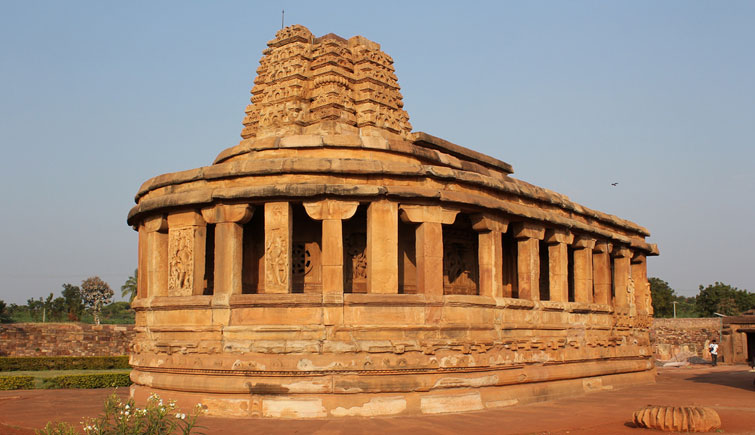
Constructed between the 7th and 8th centuries, Aihole’s Durga Temple is one of the oldest temple structures built on the banks of Malaprabha River. Often visited by tourists, this shrine is adorned in a blend of Dravidian, Nagara, and southern Mandapa style of architecture, with the temple mainly built in the Gajaprastha style, and famed for its unique semicircular apsis. The exteriors of the shrine from the elevated plinth to the corridor have detailed sculptures of arts designed on it.
Even though the temple is called the Durga Temple, Goddess Durga is not the primary deity of this temple in Karnataka, but is dedicated mainly to Lord Vishnu and Lord Shiva. In Kannada, the term “Durga/Durg” means a fortress and since the temple was part of a larger fort complex, the name was caught on and hence the temple came to be known as the Durga Temple, though the temple does have a beautiful sculpture of the goddess along with many other intricately carved sculptures that adorn the walls, and ceilings of the temple.
- Main Deity:
- Place: Aihole
- Highlight: See the sculpture of Goddess Durga killing the demon Mahishasura, Lord Shiva with his vehicle Nandi, and Lord Vishnu in his Narasimhavatara and Varahavtara.
Also Read: Best Places to Visit in Mangalore
Bhutanatha Temples: Explore the temple of Bhootnath and witness different incarnations of Lord Vishnu
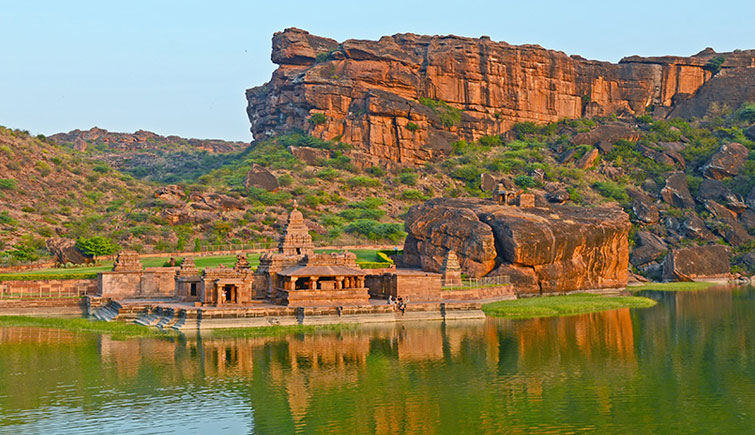
Built in a mixed variation of north and early south Indian style of architecture, this popular group of sandstone temples called Bhutanatha Temples is a place that must be visited in Karnataka. Circulating the pristine lake of Agastya and Rocky Mountains of Badami, this temple is dedicated to Bhutanatha, an incarnation of Lord Shiva. Here, you can find two sets of temples, Bhutanatha on the east and Mallikarjuna on the north-east.
The Bhutanatha Temple is said to have been built during the reign of the Chalukyas of Vatapi, with Vatapi being an earlier name for Badami. Later additions to the temple’s structure were added by the Kalyani Chalukyas of the west who are also credited with the creation of the Mallikarjuna Temple. The Bhutanatha Temple is a blend of north Indian and early south Indian style of architecture with the temple’s inner halls built by the Chalukyas of Badami and the outer hall built later by the Kalyani Chalukyas. At the temple one can see massive pillars with lotus designs with sculptures of Goddess Ganga and Goddess Yamuna on either side of the temple’s doorways.
- Main Deity: Bhutanatha (incarnation of Lord Shiva)
- Place: Badami
- Highlight: Witness an interesting sight of architectural forms built during different periods of Kalyani Chalukyas in Bhutanatha Temple.
Also Read: Best Places to Visit in Coorg
Sri Krishna Temple: Pay Homage to Lord Krishna from the Kanakana Kindi in Udupi
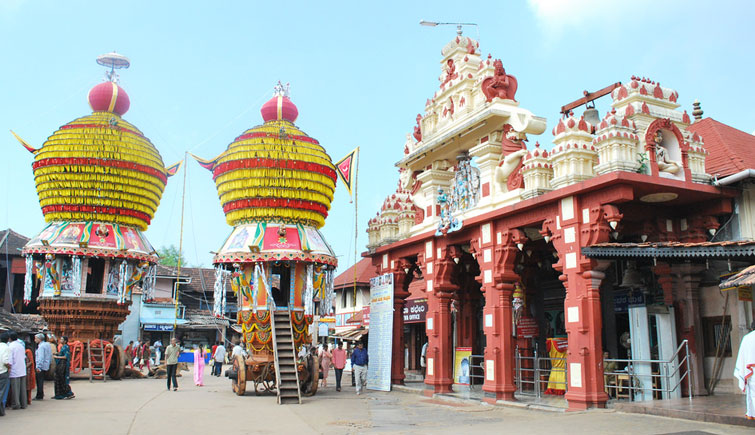
The temple dedicated to Lord Krishna, It is due to the Sri Krishna Temple of the region that Udupi in Karnataka is also referred to as the “Mathura of the south”. The temple is said to have been built in the 13th century by Sri Madhwacharya when he found the idol of Lord Krishna lying covered in gopichandana near the site. Here, unlike other temples, the idol of Lord Krishna faces in the west direction, who is depicted here as balakrishna.
What fascinates the pilgrims visiting Sri Krishna Temple in Udupi is perhaps the statue of Krishna that is faced on its back in the entrance. It is because, when Kanakadasa was denied entry in the temple due to being of lower caste, he prayed from the back of the temple. Seeing his devotion, Lord Krishna’s idol faced towards him turning his back to the entrance. And to this day, the only way to see the front of the statue is through a nine-holed window known as the Navagraha Kitiki. The statue of Kanakadasa is also displayed for the visitors to view at the Kanakadasa Mantapa near the temple.
- Main Deity: Lord Krishna
- Place: Udupi
- Highlight: The nine holes silver-plated window (Navagraha kindi) from where the deity is worshiped.
Also Read: Best Nature Weekend Getaways in Karnataka
Annapoorneshwari Temple: Visit the temple of Food Goddess and get a stunning sight of the idol in Horanadu
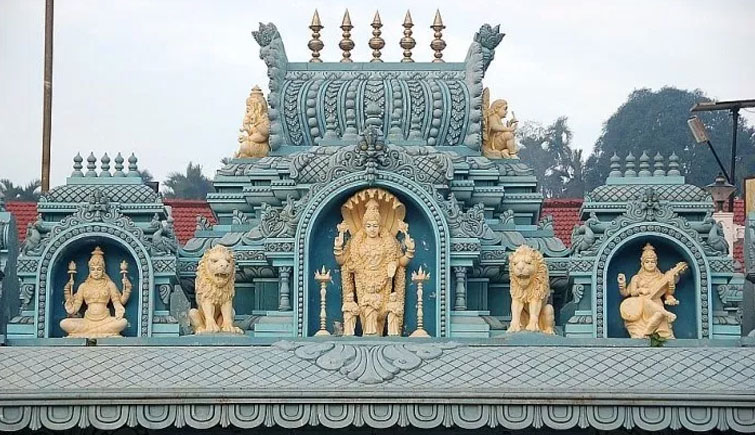
Located on the banks of Bhadra River, Annapoorneshwari Temple is deemed to be one of the oldest temples in Karnataka. This temple which is also known as Sri Kshetra Horanadu is dedicated to the Goddess of food, Goddess Annapoorneshwari. The temple lies in the Horanadu village and is part of the Chikmagalur district of Karnataka. The original deity of the temple is said to have been installed by Agastya Maharishi several centuries ago around the 8th century, with the current deity having been installed by Adi Shanakaracharya in 1973.
Being the goddess of food, it is believed that those who pray to her will never face any scarcity of food ever. With such a mindset, the temple also provides food to the devotees as prasadam. Even though the temple sees crowds throughout the year, it sees the most number of devotees during the occasion of Navratri and Akshaya Tritya. Inside the temple, you can witness a beautiful statue of the Goddess Annapoorneshwari in a standing pose, which as per the legends is said to be built by the sage Agastya.
- Main Deity: Goddess Annapoorneshwari
- Place: Horanadu
- Highlight: Pilgrims believe the temple to possess magical powers and that if prayed wholeheartedly, the devotee will never go hungry throughout his/her life.
Also Read: Best Places to Visit in Bangalore
Veera Narayana Temple: Explore the temples architectural wonder and seek blessings from the fourth incarnation of Lord Vishnu
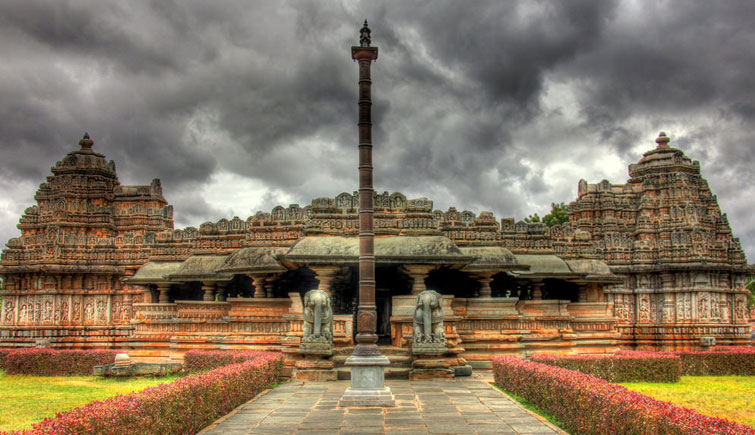
The architectural splendor of Veera Narayana Temple is worthy to applaud located in Belavadi, in Chikmagalur, the temple town finds mention in the epics of Mahabharata. The temple is a splendid work of rich architecture built by the Hoysala Kingdom during their reign. Belavadi, which was known as Ekachakra Nagara, was the place where Bhima is said to have fought with the demon Bakasura and defeated him.
Belavadi is also known for being the place where the Pandavas spent their period of exile. The temple is a trikutachala, which means that it has been built with three shrines. The temple was first constructed in 1117 CE as an ekatuka, and housed the idol of Lord Veera Narayan. It was later in 1200 CE, that two more garbhagriha were added to the structure to worship Lord Krishna and Lord Yoga Narasimha. Made out of soapstone, the temple has around 84 carvings of elephants with each differing from the other. Even though the inner walls of the temple might be plain, the outer walls are completely covered in exquisite carvings. The idol of the deity Lord Veera Narayana stands atop a lotus pedestal holding a gada, a lotus, performing a vyagraha, and the veera mudra with his four arms. The idol also has the ten incarnations of Lord Vishnu carved alongside him as well.
- Main Deity: Lord Narasimha (incarnation of Lord Vishnu)
- Place: Belavadi
- Highlight: Narasimha Jayanti is a major festival celebrated in Veera Narayana Temple during the month of April.
Also Read: Top Places to Visit in Mysore
Kukke Subramanya Temple: Receive a shower of blessings and relish the panoramic view of Kumara Parvatha
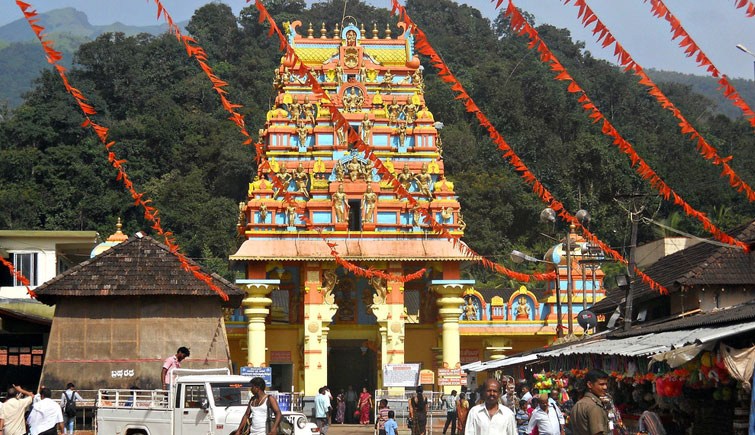
Overlooking the best trekking spot of Kumara Parvatha mountain, the 5000 year old temple of Kukke Subramanya, resides luxuriously surrounded by an abundance of natural beauty in Karnataka. This temple is dedicated to the son of Lord Shiva, Kartikeya who is worshiped as Lord Subramanya, the serpent king. It is said that the serpents including Vasuki seeked refuge under Lord Kartikeya when they were threatened by the Garuda, Lord Vishnu’s carrier bird.
Based along the Kumaradhara River, the Kukke Subramanya Temple worships Lord Subramanya as a snake deity. Devotees come from different places to offer prayers and pooja to the deity to absolve them of Naga Doshas. The Kukke Subramanya Temple is also part of the seven abodes of salvation that are spread throughout the state, established by Parashurama. Along with poojas and rituals, a ritualistic dance called the Nagamandala is also performed at the temple. Apart from absolving people of Naga Doshas, the temple is also said to heal people with skin diseases as well.
- Main Deity: Lord Subramanya
- Place: Subramanya
- Highlight: Garuda Pillar fully covered in silver and that devotees crossing Kumaradhara River are to take a holy dip before entering Kukke Subramanya Temple.
Also Read: Top Hill Destinations in Karnataka
Lakshminarayana Temple: Relish the beauty of Soapstone built temples in Hoysala Style in Hosaholalu
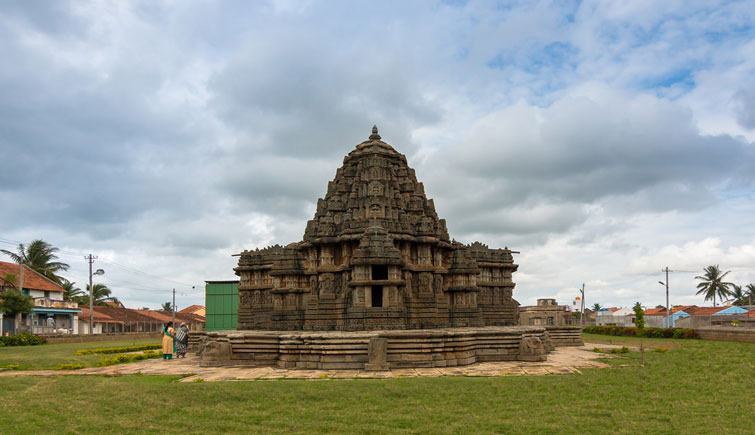
Known for its beautiful sculptured walls that display the various images of Hindu deities, the temple of Lakshminarayana also offers striking architectural beauty. Inspired by the trikutachala temple with their three shrines, the Lakshminarayana Temple is completely built using soapstone. The interior of the temple features four polished lathe that supports the roof and other pillars that separate the halls into nine compartments. Like any other south Indian temples, the temple is built on top of a three-meter platform known as jagati, and showcases splendid examples of art from the Hoysala period.
Constructed during the 13th century, the Lakshminarayana Temple is also a splendid temple created by the Hoysala Empire. The temple portrays the architecture style of the Hoysalas and stands on a star-shaped platform, a signature of the empire. There are beautiful carvings that can be found throughout the temple, with them displaying birds, fish, elephants, horses, along with mythological tales and stories from the Puranas. A temple dedicated to Lord Vishnu, several sculptures of him with his consort can be seen throughout the temple, along with him holding the lotus, conch, chakra, and mace with his four arms. At the temple, you can also see sculptures of the Samudra Manthan and the four-faced sculpture of Lord Brahma.
- Main Deity: Lakshminarayana, a manifestation of Lord Vishnu
- Place: Hosaholalu
- Highlight: You can find images of Narayana and Venugopala in the middle of the temple complex along with the images of Lakshmi Narasimha in their various forms of Vishnu.
Also Read: Top Tourist Destinations of Karnataka
Murudeshwara Temple: Admire the attractive gopuram and the second tallest statue of Lord Shiva in Murudeshwar
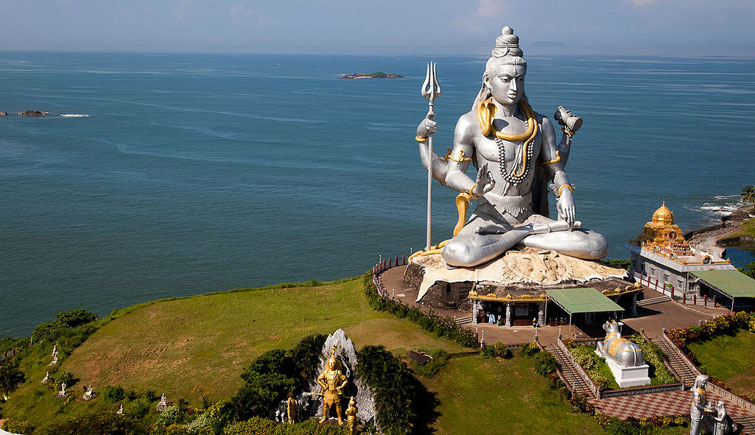
Perhaps Murudeshwara Temple’s main attraction is the 22-storied high gopuram better known as the monumental tower, towering over a height of 237 ft along with the tall statue of Lord Shiva measuring up to 123 ft. in height, known to be one of the tallest statues of Lord Shiva in the country. Located on the edge of the Kanduka Hill overlooking the Arabian Sea, one can simply visit this place and seek bliss.
Standing in the coastal town of Karnataka, the Murudeshwara Temple is dedicated to the worship of Lord Shiva and displays sculptures built by Chalukyas and Kadambas in the Dravidian style of architecture. Being located on a hilltop, the temple provides breathtaking views of the Arabian Sea that surrounds it on its three sides. Along with the mesmerizing statue of Lord Shiva overlooking the Kanduka Hill, the Murudeshwara Temple also has a sculpture of Arjuna receiving the Gitopadesha from Lord Krishna on his golden colored sun chariot.
- Main Deity: Lord Shiva
- Place: Murdeshwar
- Highlight: The second tallest Shiva statue in the world measuring 123 ft. in height.
Also Read: Best Places to Visit in Chitradurga
Kollur Mookambika Temple: Seek blessings and adore the simple architecture of the temple of Goddess Parvati in Kollur
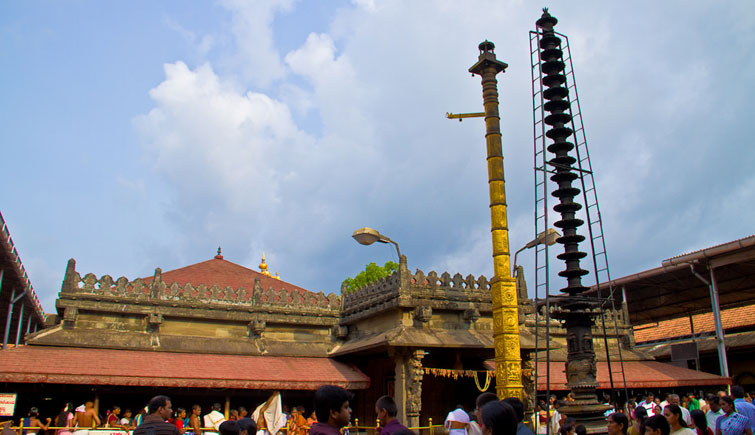
Mookambika Temple dedicated to Goddess Parvati in Kollur is one of the most visited temples in South India and is built on the Kodachadri hills in the village of Kollur of the Western Ghats. The temple offers a simplistic decor and is believed to be built around 1200 years ago. The Kollur Mookambika Temple is one of the seven abodes of salvation spread throughout Karnataka, having been established by Parashurama.
With a golden crest and copper roof, the temple is beautiful to look at and provide a sense of peace and tranquility to its visitors. The Kollur Mookambika Temple is said to have been consecrated by Adi Shanakaracharya who visited the temple to perform penance. Located along the banks of River Souparnika, the temple worships the power of the goddesses Parvati, Mahalakshmi, and Saraswati together as Mookambika at the temple.
- Main Deity: Goddess Parvati, Mahalakshmi, and Saraswati
- Place: Kollur
- Highlight: Navratri Festival is an auspicious event to witness celebration at Kollur Mookambika Temple held during the month of October. Also witness three forms of worship to Goddess Parvati. The morning in the form of Maha Kali (goddess of power), at noon as Lakshmi (goddess of wealth) and in the evening as Maha Saraswati (goddess of knowledge).
Other Interesting Blogs to Read
Must Explore Temples in Tamil Nadu, South India
Popular temples that can be visited in Tamil Nadu include the following:
- Shore Temple
- Ramanathaswamy Temple
- Murugan Temple
- Thillai Nataraja Temple
- Naganathaswamy Temple
- Kapaleeswarar Temple
- Meenakshi Temple
- Kumari Amman Temple
- Ramaswamy Temple:
- Ekambareswarar Temple
Shore Temple: Explore the seventh-century marvelous temple by the seaside in Mahabalipuram
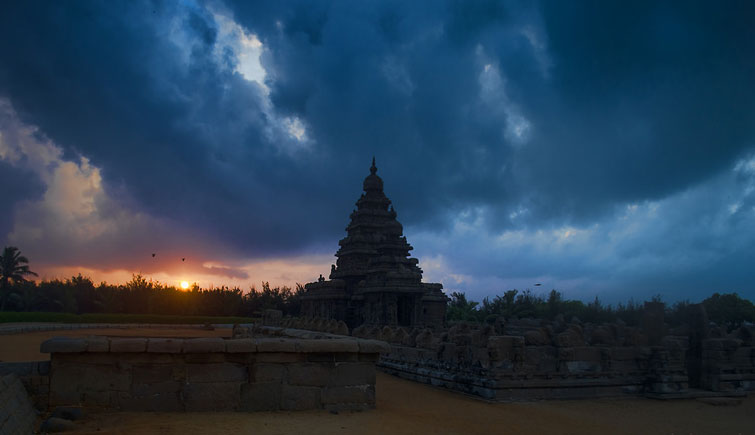
The 7th century Shore Temple is truly a remarkable tourist attraction that sits on the coastline of the Bay of Bengal. Noted to be a UNESCO site, it was believed to have a collection of temples but due to natural disaster the temple comprises only three shrines dedicated to Lord Shiva and Lord Vishnu. Throughout the exterior of the complex, you’ll notice artistic sculpted images and copious idols of Gods and Nandis.
The Mahabalipuram group of temples consists of many rock-cut caves, temples, monolithic temples, and many structures that remain ruined today. Built in the 7th century by the Pallavas who ruled the region during that time, they are credited for creating the beautiful structures, some of which still stand strong even after the passage of time. The group of temples consists of two temples dedicated to Lord Shiva with one smaller temple for Lord Vishnu. Overlooking the Bay of Bengal, the Shore Temples at Mahabalipuram is a religious as well as a heritage structure that leaves the remnants of the past for its visitors to witness.
- Main Deity: Lord Shiva and Lord Vishnu
- Place: Mamallapuram
- Highlight: Mahabalipuram Dance Festival is a major highlight held every January or February in order to promote tourism.
Also Read: Best Places to Visit in Mahabalipuram
Ramanathaswamy Temple: Perform pilgrimage at one of the Chardhams to attain Moksha in Rameswaram
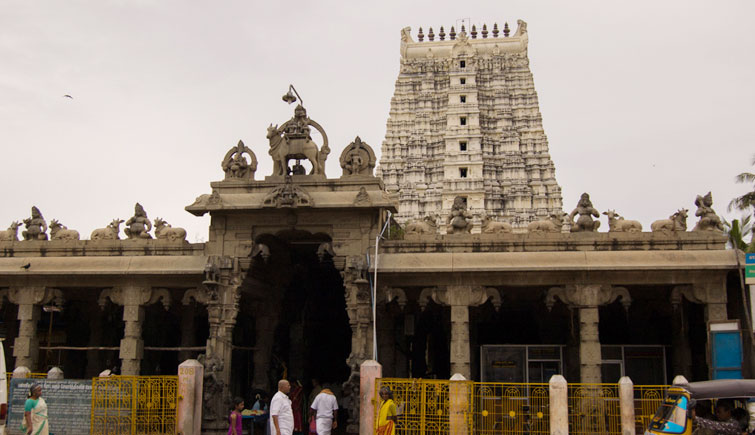
Located on the Pamban Island of Rameswaram, Ramanathaswamy Temple with the same name offers a strong spiritual vibe during the visit. Perhaps, it has something to do with the legend of Ramayana where Lord Rama prayed to Lord Shiva to seek forgiveness in order to kill his devotee Ravana. Inside the temple complex, you’ll find one of the 12 Jyotirlingas and 22 teerthams or waterbodies in the form of tanks and wells. It is considered highly auspicious for the devotees to take a dip in the Teerthams as it is believed that doing so would atone them of their sins.
The Ramanathaswamy Temple, along with being part of the 12 Jyotirlingas also forms a part of the four Char Dham temple pilgrimage circuit. At the Ramanathaswamy Temple, Lord Shiva is worshiped in the form of the Shivalinga. With its magnificent beauty, fascinating structure, long corridors, and intricately carved pillars, the temple stands tall with a 124 ft. tall Gopuram. The temple also houses an idol of Nandi, the carrier of Lord Shiva with a height of 17.5 ft. Goddess Vishalakshi, Parvathavardhini, Lord Vinayaka and Lord Subrahmanya, Utsava idol, Sayanagriha and Perumal are some of the deities worshiped at the temple apart from the main deity, Shiva.
- Main Deity: Lord Shiva
- Place: Rameswaram
- Highlight: This temple is said to have the longest corridor from all the other Hindu temples in India and the world, about 3000 feet long.
Also Read: Top Destinations in Tamil Nadu
Murugan Temple: Get a splendid view of the ocean and wander amid the largest temple complex in India in Tiruchendur
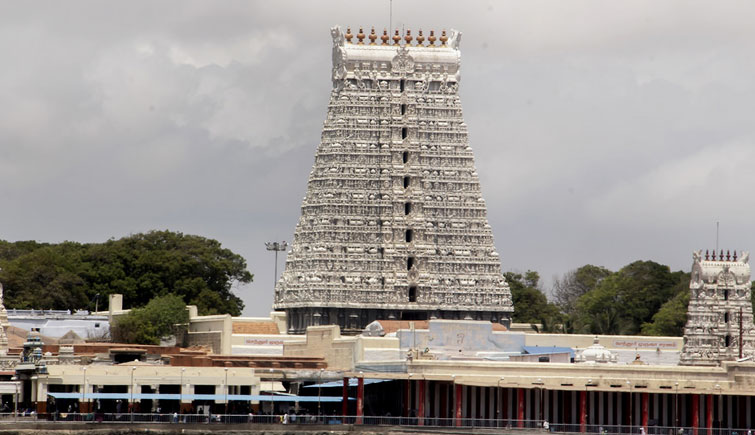
This ancient temple of Murugan is not only one of the richest temples of Tamil Nadu but it also has one of the largest temple complexes in India. Dedicated to Lord Murugan, the temple is completely built using red sandstone rock as the temple foundation with the beautiful Gopuram, giving it that iconic look. An added feature of the Murugan temple are the 120 columns and 16 pillars of Ananda Vilas Mandap that stand on a cliff and offer a splendid view of the sea.
Located in the coastal town of Tiruchendur in the Thootukudi district of Tamil Nadu, Murugan Temple attracts thousands of devotees every year. The Murugan Temple at Tiruchendur is said to have been built to commemorate the victory of Lord Murugan over the demon Surapadman after a long battle. The gopuram of the temple is 9 storey tall with a height of 137 ft. and is believed to have been constructed over 300 years ago. Another feature of the temple that differentiates it from other temples in the state is the fact that the Gopuram of the temple stands facing in the west direction unlike other temples that face in the east direction.
- Main Deity: Lord Murugan
- Place: Tiruchendur
- Highlight: A procession of Sri Jayanthi Nathar with Valli and Deivanai is witnessed during the festival of Vaikasi Visagam during May – June. A 12 day Masi Festival during February – March is also an auspicious event.
Also Read: Popular Temples in Chennai
Thillai Nataraja Temple: Witness the wall carvings of 108 karanas from the Natya Shastra in Chidambaram
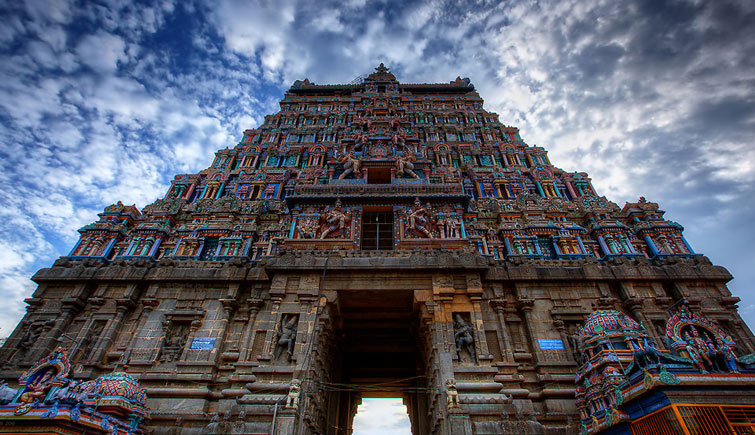
With the temple’s architecture that gives a mixture of arts and spirituality, Thillai Nataraja Temple is one of the best temples dedicated to Lord Shiva in Tamil Nadu. Located in Chidambaram that was once called Thillai, you’ll find beautiful wall carvings that display 108 karanas from the Natya Shastra. These various postures in Natya Shastra made by Bharata Muni (an Indian Theatrologist and Musicologist) forms a foundation of Bharatanatyam, the classical Indian dance that originated in Tamil Nadu.
It was during the 10th century that the Thillai Nataraja Temple was created, when the Chola Dynasty was still ruling Chidambaram. The temple was built by the Chola Dynasty who considered Lord Shiva to be their clan guardian. Not only a place of religious importance, the temple is also important for the people culturally, due to the worship of Lord Shiva’s form of Nataraja. Apart from Lord Shiva, the temple also worships Lord Vishnu and the Shakti goddesses as well. At the temple you can view Lord Shiva portrayed as Nataraja who can be seen performing the Ananda Tandava.
- Main Deity: Lord Shiva
- Place: Chidambaram (earlier known as Thillai)
- Highlight: Thillai Nataraja Temple, also known as Chidambaram temple is said to be one of the five Panch Bhuta Stalam that represents the five classical elements.
Also Read: Best Places to Visit in Kodaikanal
Naganathaswamy Temple: Get healed by taking a dip in the holy tanks at Lord Rahu’s Temple in Thanjavur
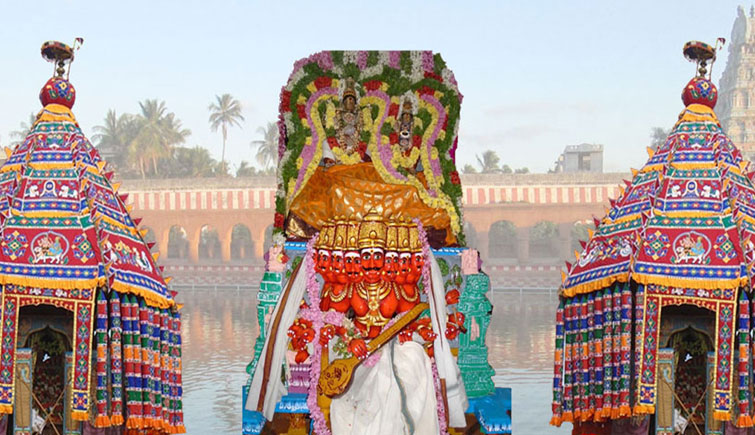
Naganathaswamy Temple in Thanjavur is one of the most-visited Navagraha Temples in whole of India and features four entry towers with fort-like walls. The eastern gateway to the temple allows the devotees to visit the Nandeeswarar Mandapam, Vinayaga temple, Thwaja Sthambam and Balipeedam. While on the southern gate, you’ll come across four mandapas adorned with elegant pillars.
Naganathaswamy Temple has twelve sacred water heads in this place and a dip in one of these holy waters is said to cure diseases and also eradicate one’s bad karma. Said to have been built in the 9th century by the Chola Dynasty, the temple is dedicated to Lord Rahu. At the temple, the idol of the Lord can be seen standing with his two consorts, Nagavalli and Nagakanni. It is said that it is at the Naganathaswamy Temple that Lord Rahu prayed to Lord Shiva to relieve himself from a curse. Filled with many gopurams and mandapas, visiting the Naganathaswamy Temple is truly a fulfilling experience.
- Main Deity: Lord Rahu (Raaghu Bhagvan)
- Place: Thanjavur
- Highlight: The only temple so far to have a human form statue of Lord Rahu, while other temples have his idol in a serpent form.
Also Read: Best Tourist Places in Ooty
Kapaleeswarar Temple: Take pleasure in marveling at the monumental tower and taking a spiritual walk in Goddess Chennai
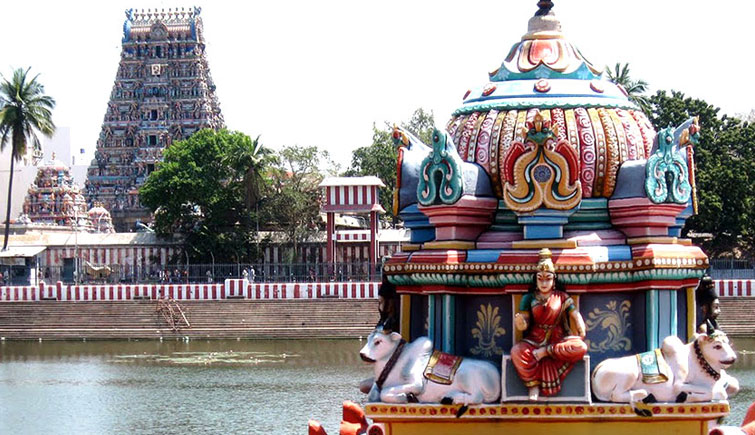
This 7th century Kapaleeswarar temple in Chennai offers divine and blissful ambience with a colorful monumental gatehouse tower, or the Gopuram. Displaying a beautiful example of the architectural style of Dravidian architecture, you’ll find many inscriptions on the temple walls dating back as far as the 12th century. Dedicated to Lord Shiva and Goddess Parvati, the temple has been built by the Pallava Kings and later by the Vijayanagara Empire.
The temple is memorable for it is said that this was the place where Goddess Parvati came down to pray to Lord Shiva as a penance after she got turned into a peahen, which is why even today you can see peacocks and peahen in the premises of the temple. Another story talks about how it was at the site of the temple that Lord Brahma came to pray to Lord Shiva after Shiva removed one of Lord Brahma’s head in rage when he was shown disrespect. Here, “Kapalam” means “Head” and “Eeshwar” means “Lord”, hence the name of the temple. At the temple the devotees can witness six different types of puja’s in Kapaleeswarar Temple such as Vaikarai Pooja, Uchi Kala Pooja, Ko pooja, Kala Sandhi Puja, Kali Puja, Evening Puja and Ardhajama Pooja.
- Main Deity: Goddess Parvati (in the form of Karpagambal)
- Place: Chennai
- Highlight: This temple is widely visited during festivals like Arupathu Moovar Festival, Theppa Thiruvizha Float Festival, Vasantha Utsavam Festival and even the Navaratri Festival.
Also Read: Must Visit Temples in Tamil Nadu
Meenakshi Temple: Witness the colorful gopurams and emerald built deity of Goddess Meenakshi
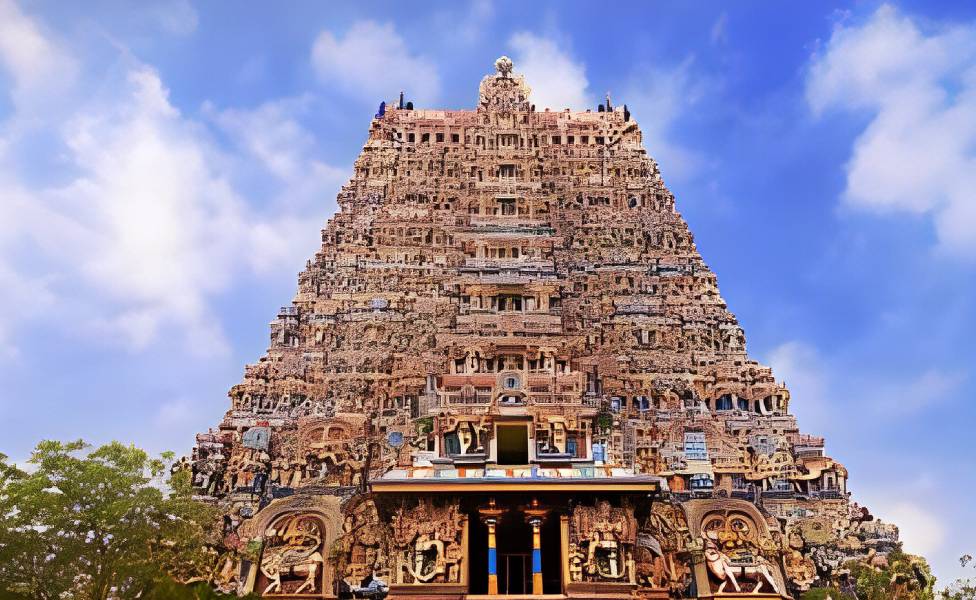
Located on the southern bank of the river Vaigai in Madurai, Meenakshi Temple is noted to have the largest temple complexes in Tamil Nadu. It can be justified by wandering amidst the 14 gopuram (monumental gatehouse towers) located in equal distance from each other, with the tallest among them standing at a height of 170 ft. The majestic beauty of the temple is witnessed from the architecture that displays the image of Goddess Meenakshi, various sculptures and coiled corridors around the complex.
The Meenakshi Temple is dedicated to Goddess Meenakshi and her consort Lord Sundareshwar, and is said to be over 2000 years old with the present structure being built between the 12th and the 16th centuries. A magnificent example of Dravidian temple architecture, the Meenakshi Temple is known for its colorful gopurams that make it stand out from the rest of the temples in the region. The sculptures that cover the gopurams are known for portraying the various tales from Hindu mythology and events from the scriptures. Apart from the gopurams, the Hall of Thousand Pillars or the Aayiram Kaal Mandapam is also a fascinating attraction of the temple, featuring beautifully carved pillars in the temple hall, although not accurately a thousand.
- Main Deity: Lord Shiva (in the form of Sundareswarar)
- Place: Madurai
- Highlight: The image of Goddess Meenakshi inside the temple is believed to be carved out of a single emerald.
Also Read: Best Places to Visit in Rameshwaram
Kumari Amman Temple: Explore the place where Goddess Parvati performed penance to marry Lord Shiva
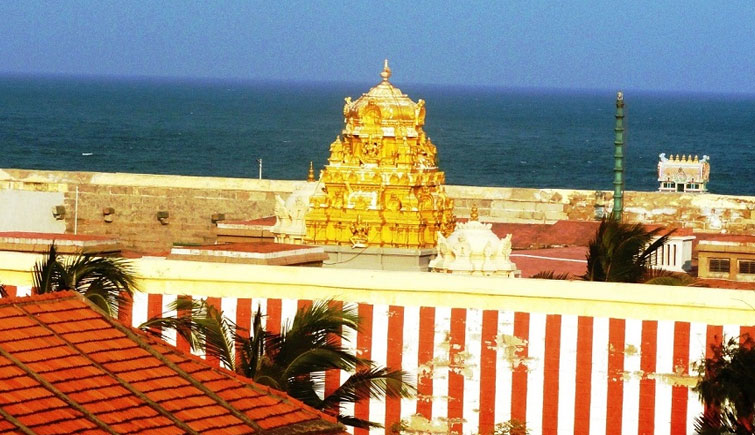
Established on the southernmost tip of India, along the shore of Kanyakumari, the temple of Kumari Amman is devoted to the virgin Goddess, Devi Kanya Kumari. This 8th century shrine was built by the Pandya Kings and later renovated by the following rulers of Chola, Vijayanagar and Nayak Dynasties.
Dedicated to the Goddess Kanyakumari, the Kumari Amman Temple is among the 108 Shakti Peethas that are spread throughout the Indian subcontinent. The idol of the Goddess at the temple has a nose ring that itself has many stories and legends attached to it. The beautiful temple of Kumari Amman is situated along the beach of Kanyakumari and therefore attracts numerous devotees as well as tourists who come to visit the temple every year. Carved out of bluestone, the idol of the temple is a prominent point of interest at the temple. According to the legend surrounding the temple, Goddess Kanyakumari is an incarnation of Goddess Parvati herself, who took the form to kill the demon Banasura who was only able to die at the hands of a virgin girl.
- Main Deity: Goddess Kanyakumari (Parvati)
- Place: Kanyakumari
- Highlight: A 9-day Navratri festival during September–October is joyously celebrated followed by festivals of Vaisakha and Kalabham.
Also Read: Popular Hill Stations in Tamil Nadu
Ramaswamy Temple: Pay Homage to Lord Rama and take a walk along a series of stone carvings with several mythological depictions
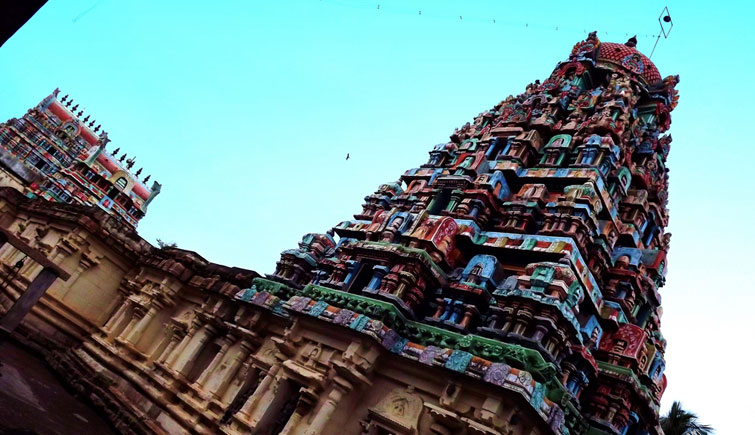
One of the most popular Rama temples in Kumbakonam, Ramaswamy Temple is a 16th century structure built by Achutha Nayaka of Thanjavur. The seventh incarnation of Lord Vishnu is worshiped in this temple and unlike other Rama temples, one can get a spectacular sight of Lord Rama with his wife Sita along with his devotee Lord Hanuman and all of Lord Rama’s brothers- Lakshmana, Bharata, and Shatrughna.
Built by the Nayakkar Kings, the Ramaswamy Temple in Tamil Nadu was constructed in the 16th century. Portraying the signature style of Nayakkar architecture, the temple has three-tiered gopurams within its walls. Along with the gopurams, you can see many pillars along the temple. The temple displays stories and tales from Hindu mythological scriptures in its 64 pillars, and has been made using a single stone. At the temple you will also find a series of stone carvings of Meenakshi Kalyanam, Rama-Katha, Vamana Avatharam and more. Apart from these, you can also find the Chitra Ramayana carved on the outer walls of the temple, displaying the stories from the epic of Ramayana.
- Main Deity: Lord Rama
- Place: Kumbakonam
- Highlight: Explore 219 wall paintings in the temple that explain the episodes of the epic story of Ramayanam.
Ekambareswarar Temple: Witness an array of Shiva Lingam and 63 granite images of the Nayanmars in Kanchipuram
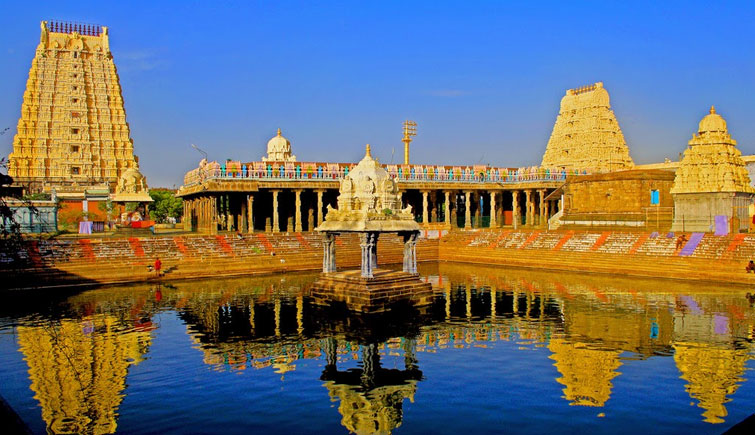
Considered to be one of the important pilgrimage centers in India for Shiva devotees, you can plan a visit to Ekambareswarar and wander amidst the temple complex that displays a number of staggering gopurams. Inside the temple, you’ll witness an array of Shiva Lingam and 63 granite images of the Nayanmars. The architecture of the temple looks even more radiant, having a beautiful pond in the center of the complex.
The Ekambareshwar Temple is part of the Panch Bhuta Stalam or five prominent Shiva temples that are located across the states of Tamil Nadu and Andhra Pradesh. These temples represent the five elements of the universe such as air, water, earth, fire, and space, from which the Ekambareshwar Temple represents the earth or Prithvi. At the temple, Lord Shiva is worshiped as the Shiva Lingam which is known as the Prithvi Lingam. According to a legend related to the temple, it was Goddess Parvati who built the Prithvi Lingam out of sand and worshiped it under a mango tree. One of the largest temples in Kanchipuram, the Ekambareshwar Temple is spread over an area of 40 acres of land.
- Main Deity: Lord Shiva
- Place: Kanchipuram
- Highlight: The months between March and April witness the festival of Panguni which is celebrated for 10 days.
Other Interesting Blogs to Read
Must Visit Temples in Andhra Pradesh, South India
Popular temples that can be visited in Andhra Pradesh include the following:
- Mallikarjuna Swamy
- Veerabhadra Temple
- Venkateswara Swamy Temple
- Anjaneya Temple
- Kanaka Durga Temple
- Mahanandi Temple
- Yaganti Temple
- Srikalahasteeswara Temple
- Simhachalam Temple
- Gollalamamidada Rama Temple
Mallikarjuna Swamy: Dig into the history of the temple and find inscriptions from the time of Satavahana Dynasty in Srisailam
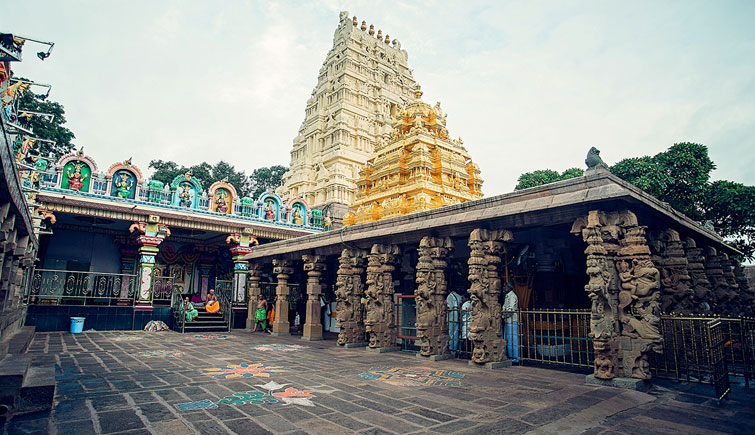
This popular Hindu temple in Andhra Pradesh is dedicated to Lord Shiva and Goddess Parvati and is said to be one of the twelve Jyotirlingas shrines dedicated to Lord Shiva in India. Situated on top of a flat area of Nallamala Hills, the Mallikarjuna Swamy temple displays beautiful inscriptions from the Satavahana Dynasty on the temple walls. You can explore its four gopurams, sculpted pillars, mirror hall that houses the image of Nataraja along with numerous shrines and sculptures.
Located in the hill town of Srisailam in Andhra Pradesh, the Mallikarjuna Swamy Temple is one of the most popular temples in India, having both a Jyotirlinga and a Shakti Peetha of the Sri Bhramaramba Devi Temple within the same temple complex. A temple that has been in existence for centuries, the Mallikarjuna Swamy Temple is said to have been reconstructed by the Vijayanagara King, Harihara Raya. Sitting along the banks of the River Krishna, the Mallikarjuna Temple is a must visit temple for the devotees of the divine couple of Lord Shiva and Goddess Parvati.
- Main Deity: Lord Shiva and Goddess Parvati
- Place: Srisailam
- Highlight: Maha Shivaratri and Navratri are the two auspicious festivals celebrated in this temple.
Veerabhadra Temple: See surplus 16th Century carvings and fresco paintings of done in Vijayanagara architectural style in Lepakshi
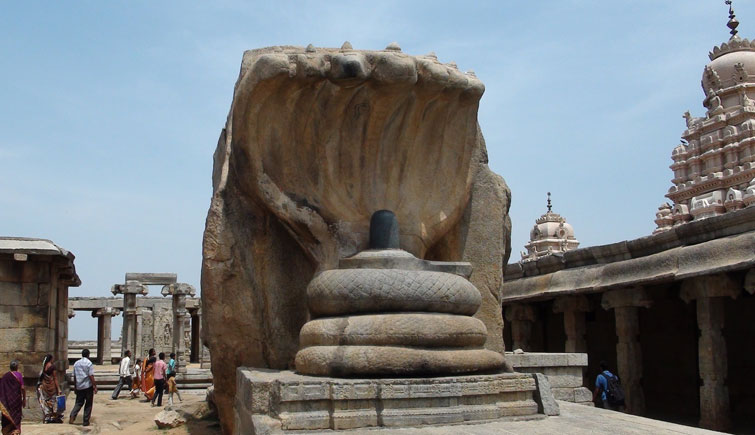
Veerabhadra Temple is one of the famous ancient temples located in the state of Andhra Pradesh, displaying intricate carvings all across the temple. This 16th century shrine features Vijayanagara style of architecture with fresco paintings on the ceilings and walls displaying in detail every scene of Rama and Krishna from the tale of Ramayana and Mahabharata. The temple is a heritage monument and displays beautiful works of art, history, and devotion that existed during the time of the Vijayanagar Empire.
The Veerabhadra Temple was made to worship Lord Veerabhadra, a fierce form of Lord Shiva. The temple is known for its astonishing architecture that features beautiful pillars and cave chambers. Not only important for the religion, the temple is also a part of UNESCO World Heritage Site’s tentative list. The temple is built in a trikuta style of temple architecture, which includes three altars for worshiping the deities. The monolithic bull sculpture representing Lord Shiva’s carrier bull Nandi is one of the popular structures in the temple complex. Another popular sculpture at the temple is the Naga-Lingam at the Veerabhadra Temple, which is a Shiva Lingam hooded by seven Nagas.
- Main Deity: Lord Veerabhadra
- Place: Lepakshi
- Highlight: Carved out from a single stone, a granite monolithic Bull or Nandi is placed about 200 meters away from the temple.
Venkateswara Swamy Temple: Adore the colorful facade and witness the unusual sight of mass hair tonsuring in Tirumala
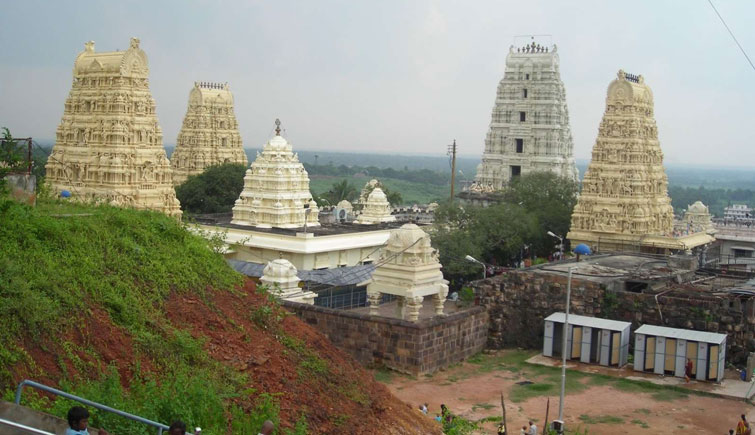
Known by various other names like Tirumala, Tirupati and Balaji, Venkateswara Swamy Temple is by far the most visited Lord Venkateswara temples in Andhra Pradesh. This holy sanctuary sits on the hills of Tirumala in Chittoor district, with the facade of the temple giving it an authentic south Indian architectural splendor of Dravidian style. This temple’s colorful Gopuram or the temple tower is said to be five stories high with the main entrance to the temple, Maha Dwaram just below.
Venkateswara Swamy Temple worships Lord Venkateswara, an incarnation of Lord Vishnu as the primary deity at the temple, and forms an important pilgrimage site for the Vaishnavite devotees. The temple is also called Bhuloka Vaikuntham, meaning the “The abode of Lord Vishnu on Earth”, who is said to have manifested on Earth during the Kali Age to provide salvation to his devotees. The idol at the temple is believed to be a Swayambhu or a “Self manifested” one, and is seen decorated with flowers and ornaments at all times.
- Main Deity: Lord Venkateswara
- Place: Tirumala
- Highlight: Witness the hair offering or tonsuring in Venkateswara Swamy Temple by the devotees and attend Vaikhanasa Agama, a traditional puja that worships all of Vishnu’s avatars.
Anjaneya Temple: Marvel at the tallest statue of Lord Hanuman at Paritala Village
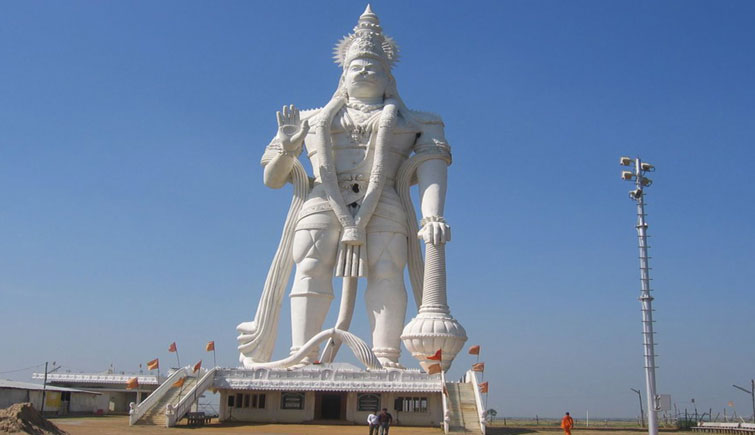
Located in the village of Paritala, Anjaneya Temple displays the second tallest statue of Lord Hanuman in the world, which is said to be 135 ft. in height. Anjaneya Temple in Paritala offers a spiritual ambience for Hanuman devotees and an open playground for the monkeys that play around showing their mischievous nature.
Installed in the year 2003, the giant statue of Lord Hanuman is what attracts devotees and tourists alike to visit the Anjaneya Temple at Paritala. The temple also has shrines dedicated to the worship of Lord Ram, Goddess Sita, and Lord Lakshmana along with the shrine of Lord Hanuman. Although the statue has been installed recently, the temple is said to have been in existence for centuries, with the current structure of the temple being constructed in the 1960s. Situated in Vijayawada, along the highway, the Anjaneya Temple in Paritala is a must visit temple for the ardent devotees of Lord Hanuman.
- Main Deity: Lord Hanuman
- Place: Paritala Village
- Highlight: The second tallest statue of Lord Hanuman standing 135 ft. in height.
Kanaka Durga Temple: Explore the golden shrine of Goddess Durga in Vijayawada
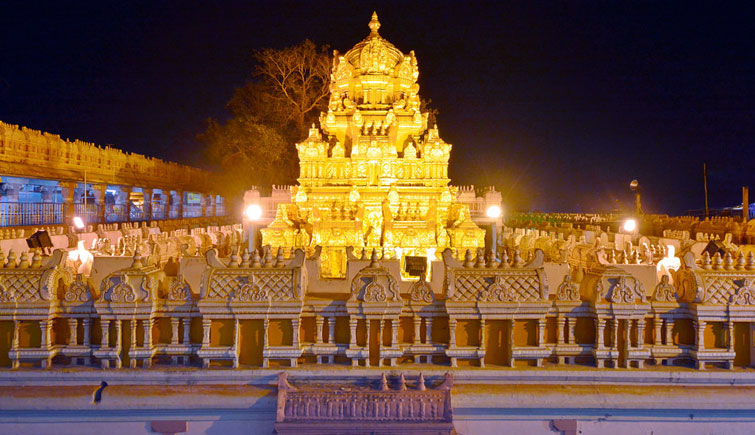
One of the most famous Durga temples in Andhra Pradesh, Kanaka Durga Temple is located amid the greens of the Indrakeeladri hill along the Krishna River. Here, a sight you’ll probably not miss is the golden coloured shrine in the center of the temple complex that houses the idol of Goddess Durga. Surrounded by huge fenced walls and a colorful monumental tower that displays images of deities, Kanaka Durga Temple is a must visit holy destination.
The presiding deity of Vijayawada, Goddess Durga is worshiped at the temple as Kanaka Durga. A popular temple that sees crowds throughout the year, the temple sees the most crowds during the occasion of Navratri, celebrated with much fervor and enthusiasm. The idol of the Goddess at the temple is said to be a Swayambhu or a “Self manifested” one, and is worshiped ardently by the devotees. The deity’s face and body are both a shade of golden, which is further adorned with gold ornaments, lending the name “Kanaka” Durga, in which “Kanaka” translates to gold in Sanskrit.
- Main Deity: Goddess Durga
- Place: Vijayawada
- Highlight: The most significant festivals are Saraswati Puja and Theppotsavam. The festival of Dasara is also an important festival during which the devotees take a dip in the Krishna river near the temple.
Mahanandi Temple: Sight the two-cavity natural Shivling in Nallamala Hills near Nandyal
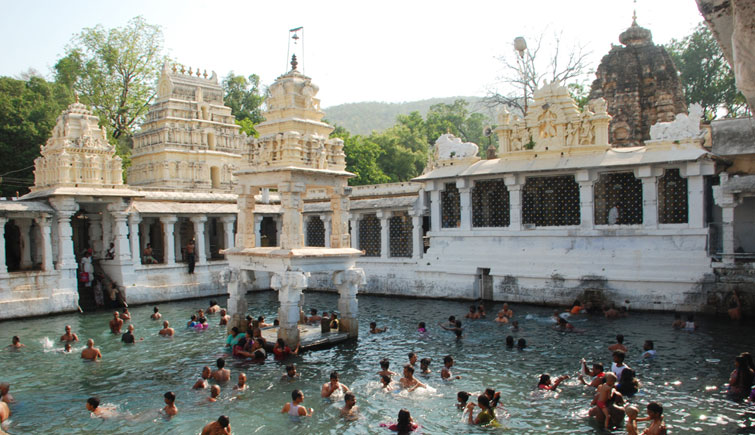
Experience a spiritual environment while visiting Mahanandi Temple dedicated to Lord Shiva. This ancient temple houses a Shivalinga which is quite unique, it is so because it appears to look like a rough rock featuring two cavities. Built in a Tamil architectural style, you’ll notice a gopuram that stands talls illuminating golden flair. And inside the temple complex, you’ll see three pools of water which are around 60 square feet with two pools outside the temple and one within the garbhagriha or the sanctum sanctorum of the temple. The main deity of the temple is Lord Shiva who is worshiped in the form of a Shiva Linga and can be seen in the garbhagriha surrounded by the pool of water.
Originally, the temple was built in the 7th century by the Chalukya Dynasty, after which many changes were made by the further dynasties of Vijayanagar and the Nandas- for whom Nandi was the guardian deity. In the village of Mahanandi, there are around nine temples dedicated to the worship of Nandi, the carrier bull of Lord Shiva. These nine temples include the temples of Mahanandi, Shivanandi, Vinayakanandi, Somanandi, Prathamanandi, Garuda Nandi, Suryanandi, Krishnanandi and Naganandi.
- Main Deity: Lord Siva
- Place: Nallamala Hills near Nandyal
- Highlight: Maha Shivaratri is joyously celebrated annually during the months of February and March.
Yaganti Temple: Hike 120 steep steps to witness miracles at the temple dedicated to Lord Shiva in Yaganti
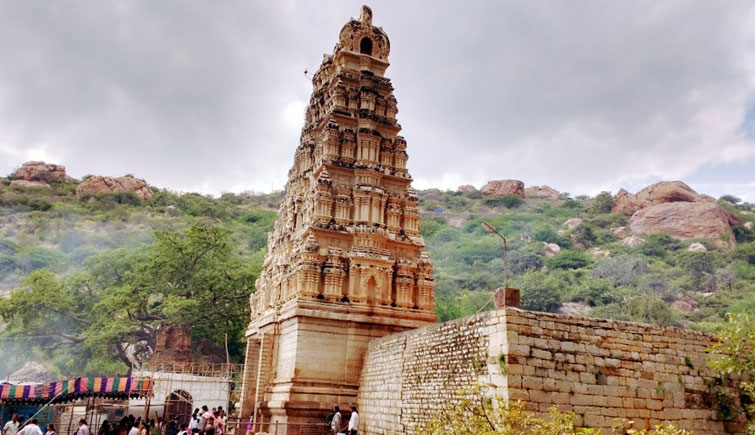
What makes Yaganti Temple famous is for the fact that the sweet water gushes into Pushkarini (a small pond) through the mouth of a Nandi from the bottom of the hill. There has been no explanation from where the water comes from, but the devotees find the water to hold special healing powers. You’ll also notice many caves around the temple complex where one can get to Agastya Cave by taking 120 steep steps. You will also find an idol of Lord Venkateswara in the Venkateswara Cave and Veera Brahmam Cave where he wrote the Kalagnanam.
Located in the Kurnool district of Andhra Pradesh, the temple is also known as Uma Maheshwari Temple and dates back to the 5th and 6th centuries. The idol at the temple is the Ardhanareeswarar form of the deities of Lord Shiva and Goddess Parvati made into one and has been carved out of a single piece of stone. Located close to the temple are many cave temples which is what Yaganti is also famous for.
- Main Deity: Lord Shiva
- Place: Kurnool District
- Highlight: The idol of Nandi located in front of the temple increases 1 inch after every 20 years. According to the Archaeological Survey of India, the rock that was used to crave the Nandi has a growing nature, however, it has not been proven.
Srikalahasteeswara Temple: Applaud the colorful gopuram and the mandapam where Lord Shiva granted Moksha to Kannappa in Srikalahasti
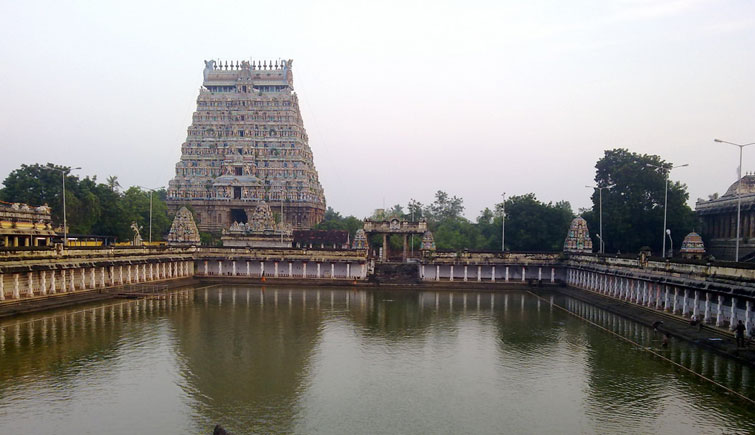
Known for the Vayu Lingam, Srikalahasti Temple in Andhra Pradesh is one of the famous Shiva temples in South India. This temple revolves around many legends, it is said that Kannappa, one of Shiva’s saints, almost removed his eyeballs in order to cover the blood flowing from the Sivalinga. Seeing his devotion Lord Shiva granted him Mukti (Nirvana). Built in a Dravidian architectural style, it has a 120 ft. high gopuram and 100 pillar mandapam.
The Srikalahasteeswara Temple forms a part of the Panch Bhuta Stalam or the five important Shiva temples that are spread throughout the states of Tamil Nadu and Andhra Pradesh, representing the five important elements of the universe, air, water, fire, earth, and space. The temple was built by the Pallava Dynasty in the 5th century and has been carved out of a single piece of rock. It was the Chola Dynasty that renovated the temple’s structure in the 10th century, and later, the Vijayanagara Kings that erected the 100 pillar mandapam of the temple. The Shiva Linga inside the temple is white in color and is believed to have been self-manifested and is called a Swayambhu one.
- Main Deity: Lord Shiva
- Place: Srikalahasti
- Highlight: The idol of Shiva located here which is in the form of Linga is said to be completely made of white stone in a shape that resembles an elephant’s trunk.
Simhachalam Temple: Take a tour of the fortress-like temple in Visakhapatnam
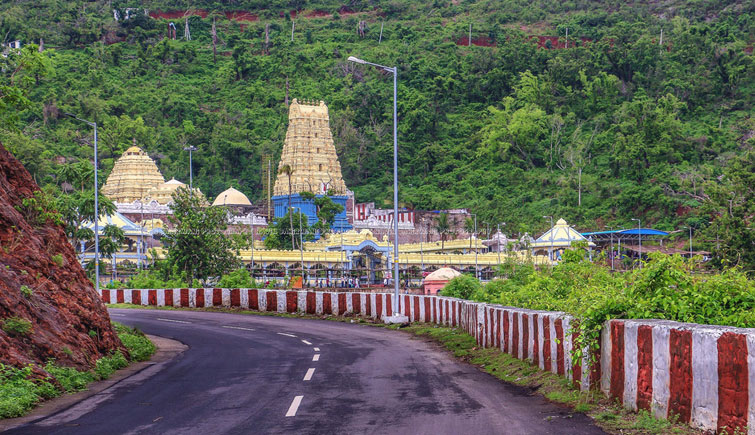
Built in Kalinga architectural style, Simhachalam Temple dedicated to Lord Narasimha (incarnation of Lord Vishnu) more or less resembles a fortress. It gives a fusion of different styles of architecture of Chalukyas, Orissan and Cholas. The temple has five gateways and the main tower or the rajagopuram in the west consists of five-tier. Here, the pillars and walls are carved with images of Lord Vishnu, Goddess Lakshmi and the Azhwars (Tamil poet-saints of South India).
- Main Deity: Lord Narasimha
- Place: Visakhapatnam
- Highlight: The five days festival of Kalyanotsavam (marriage of Varaha Narasimha) is celebrated annually.
Gollalamamidada Rama Temple: Seek blessings of Lord Rama in a temple seated by the river in Gollalamamidada
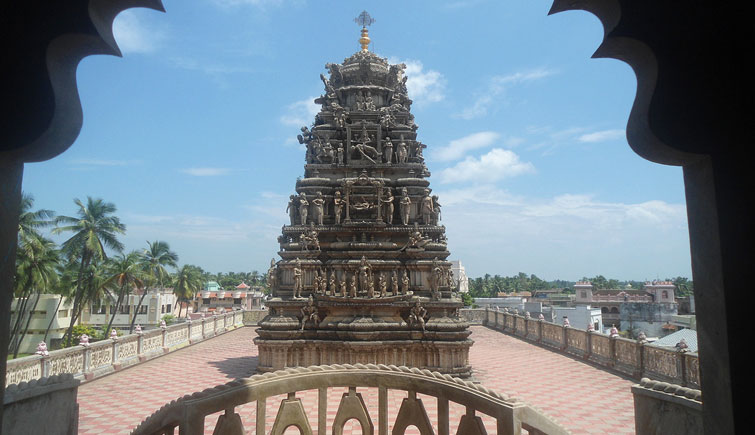
Seated on the banks of River Thulya Bhaga, Gollalamamidada Rama Temple is a well-known Hindu pilgrimage destination that gathers the followers of Lord Rama. This holy place is located in the eastern part of Godavari District of Andhra Pradesh and it is also known as Sri Kodanda Rama temple. Among the festivals that attract devotees to the temple, Rama Navami is one of the famous and auspicious festivals celebrated here.
The Gollalamamidada Rama Temple worships Lord Rama and houses the idol of Lord Rama, Goddess Sita, and Lord Lakshmana. One of the major highlights of this temple is its tall gopuram that is 170 ft tall in height. On the pious occasion of Ram Navami, the festival that is celebrated with fervor and enthusiasm is the celebration of the celestial wedding of Lord Rama and Goddess Sita, for which devotees gather to the temple from all over the region and constitutes a nine day celebration. Along with these major celebrations, the Abhishekam or Pooja is held daily at the temple.
- Main Deity: Lord Rama
- Place: Gollala Mamidada village
- Highlight: One of the major highlights of this temple is the 170 feet high Gopuram.
Also Read: Top Tourist Destinations in Andhra Pradesh
Must See Temples in Telangana, South India
Popular temples that can be visited in Telangana include the following:
- Birla Mandir
- Lakshmi Narasimha Temple
- Sita Ramachandra Swamy Temple
- Sanghi Temple
- Beechupally Anjaneya Swamy Temple
- Gnana Saraswati Temple
- Karmanghat Hanuman Temple
- Sri Raja Rajeshwara Temple
- Chaya Someswara Swamy Temple
- Narasimha Temple
Birla Mandir: Savor the beauty of all white temple in Hyderabad
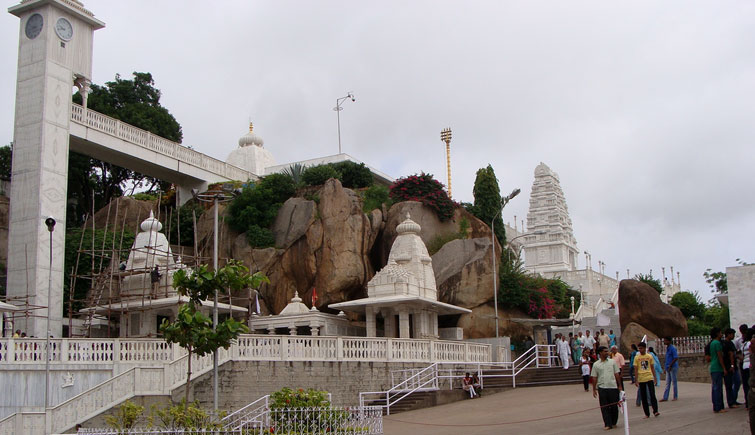
Seated on 280 ft. high Naubat Pahad hillock, Birla Temple offers the devotees with a sense of spiritual awakening. With the main deity of the temple as Lord Venkateswara, the temple houses multiple shrines of various Hindu deities and gives an opportunity to the visitors to seek blessing not only from Lord Venkateswara but other deities like Lord Shiva, Lord Ganesh, Goddess Shakti, Lord Hanuman, Goddess Saraswati, Lord Brahma, Sai Baba and Goddess Lakshmi as well. With a mixed architectural style of Rajasthani, Dravidian and Utkala, the entire temple is built in white 2000 tons of white marble.
Constructed in 1976, the Birla Mandir is a relatively new temple built by Swami Ranganathananda of Ramakrishna Mission and worships Lord Venkateswara, a form of Lord Vishnu. The idol inside the temple is canopied by a lotus made of granite rock which is in stark contrast to the white color of the idol. Located atop the hill, the temple overlooks Hussain Sagar Lake and is one of the most beautiful destinations in the city of Hyderabad. The walls of the temple are also decorated with carvings that display stories from the epics of Ramayana and Mahabharata as well.
- Main Deity: Lord Venkateswara
- Place: Hyderabad
- Highlight: The granite idol of Lord Venkateswara stands about 3.4 m and the temple has no traditional bells, in order not to disturb those meditating in the shrine.
Also Read: Top Places to Visit in Telangana
Lakshmi Narasimha Temple: Seek the blessing of Lord Narasimha and explore an ancient natural cave at Yadagirigutta
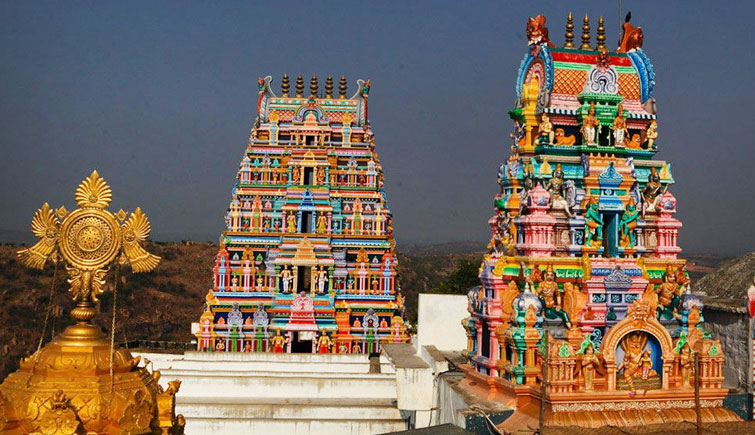
Also known as Yadagirigutta, Lakshmi Narasimha Temple is one of the popular Hindu shrines seated on a hillock in Yadagirigutta. In order to get to the main shrine that houses various idols, you will have to pass through a 12 feet high and 30 feet long cave located at the back of the temple.
The Lakshmi Narasimha Temple is an ancient temple and even finds mention in the puranas, precisely, in the Skanda Purana. On top of the Shikhara of the garbhagriha of the temple, there is a bright golden Sudarshan Chakra of Lord Vishnu, 3ft.tall and 3ft. Wide in measurements. The main deity of the temple is Lord Narasimha who is an incarnation of Lord Vishnu, whose five different forms namely, the Sri Jwala Narasimha, Sri Yogananda, Sri Gandabherunda, Sri Ugra and Sri Lakshminarasimha are worshiped at the temple today. As such, inside you will find a serpent shaped Jwala Narasimha, a silver idol of Lakshmi-Narasimha and a statue of Yogananda Narasimha in a meditating pose.
- Main Deity: Narasimha Swamy (incarnation Lord Vishnu)
- Place: Yadagirigutta
- Highlight: See Lord Vishnu in all three forms of Jwala Narasimha, Gandabherunda Narasimha and Yogananda Narasimha in Lakshmi Narasimha Temple.
Sita Ramachandra Swamy Temple: Relish the balmy environment and soak in the spirituality in Bhadrachalam
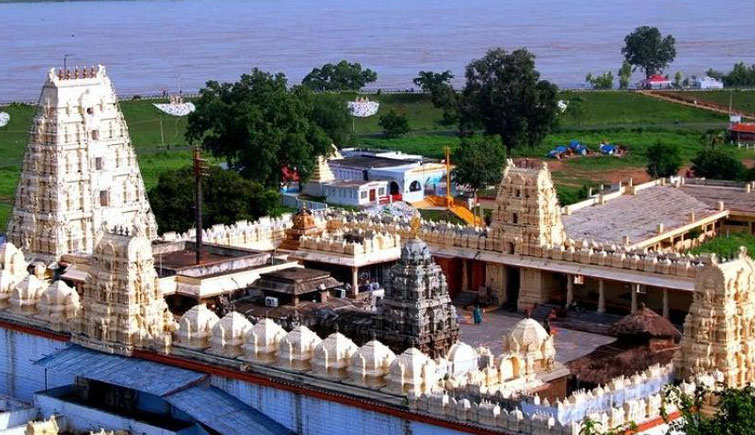
Gently seated near the shores of the Godavari River, the temple of Sita Ramachandra Swamy is a holy place to visit and offers the best of nature and spirituality. This temple is separated into three parts, the head of Bhadra, a devotee of Lord Rama is the main shrine, the second section is of the sanctum and the third part of the temple is the Rajagopuram, the main tower located at Bhadra’s feet.
The Sita Ramachandra Swamy Temple in Bhadrachalam, Telangana attracts thousands of devotees every year, especially during the festivities of Ram Navami, to celebrate the birth of Lord Rama, and his celestial wedding to his consort Goddess Sita. Bhadrachalam is a place that is also considered pious and holy for being the place where Lord Rama and Goddess Sita spent some time during their period of exile. The temple was constructed in the 17th century by a local Tahasildar, Kancharla Gopanna who was an ardent devotee of Lord Rama. The idols that exist in the temple were found by a woman called Pokala Dhammakka, who found them under an anthill as per the instructions given to her by Lord Rama, who told her that a temple for the idols would be built at a later date. As such, the temple was later built by none other than Kancharla Gopanna himself, fulfilling the prophetic dream.
- Main Deity: Lord Rama
- Place: Bhadrachalam
- Highlight: Ram Navami is an important festival celebrated in Sita Ramachandra Swamy Temple during the months of March-April.
Sanghi Temple: Feel the spiritual bliss amid serene surroundings in Sanghi Nagar
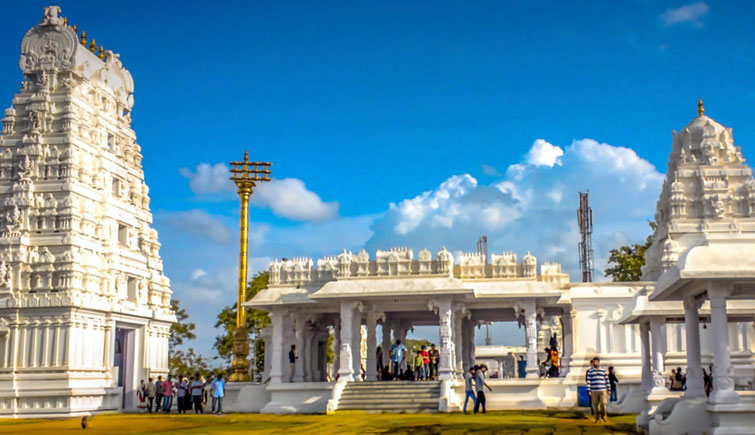
With an architectural style of Chola – Chalukya, the Sanghi Temple is located on a beautiful hillock of Paramanand Giri. As the name suggests, it was built by the Sanghi industrial group and its architectural beauty is what every visitor adores, completely covered in white. Sanghi Temple is dedicated to Lord Venkateshwara and it receives many pilgrims throughout the year. Nearby the temple complex, there are also multiple temples of deities like Goddess Parvati, Lord Anjaneya, Lord Shiva, Goddess Kamalambika, Lord Rama, Lord Ganesha, Goddess Durga and Lord Kartikeya.
Built in 1991, the Sanghi Temple is one of the popular attractions in Hyderabad. The temple complex has its own garden known as the Pavitra Vanam, from which flowers are used for the rituals and ceremonies that take place in the temple. The festivals of Shivratri, Krishna Janmashtami, Dussehra, Ram Navami, and Hanuman Jayanti are celebrated at the temple with much fervor and enthusiasm, making visiting the temple during these times a must visit experience.
- Main Deity: Lord Venkateshwara
- Place: Sanghi Nagar
- Highlight: Also considered as a weekend pilgrimage getaway, the complex highlights a garden, Pavitra Vanam and also Kalyana Mandapam for marriage events. Dussera is the best time to visit as the entire temple glitters with lights and devotees.
Beechupally Anjaneya Swamy Temple: Indulge into river worship and take a dip in the holy river to get cleansed from all your sins in Beechupally
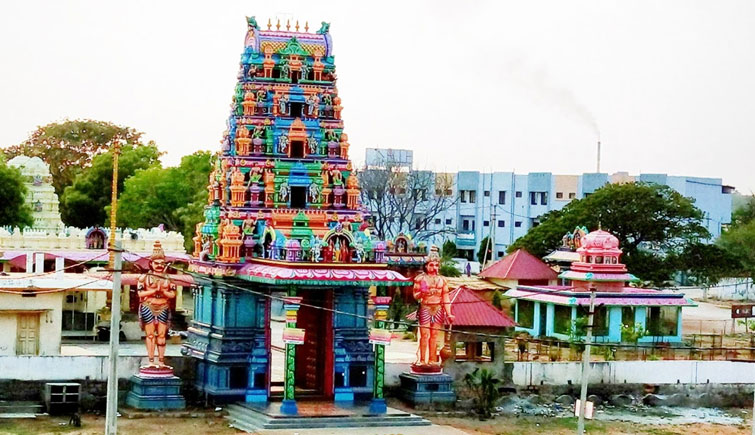
Anjaneya Swamy Temple is one of the most visited temples in Telangana, especially for Lord Hanuman devotees. Here, you’ll find many ghats since it is located near the Krishna River. One of the auspicious river worship and sacred bath events also takes place here after every 12 years, known as the Pushkara Snanam.
Being located at the shores of the Krishna River, a number of ancestral rites for the deceased are performed by the devotees at the temple. The main shrine has a Hanuman Temple that is located at a distance of 200 meters away from the river, along with a Shiva Lingam that can be seen near the river. Before going to visit the temple, it is considered auspicious to take a dip in the waters of the river for the devotees. Pilgrims who visit the temple believe that the temple will cure them of diseases and illnesses and often tonsure their hair at the temple as an offering.
- Main Deity: Lord Hanuman
- Place: Beechupally
- Highlight: One of the major highlights you can witness here is the festival of Pushkara Snanam held every 12 years, dedicated to the 12 sacred rivers in India.
Gnana Saraswati Temple: Bring your children for a ceremony of Aksharabhyasam and be blessed by Goddess Saraswati in Basar
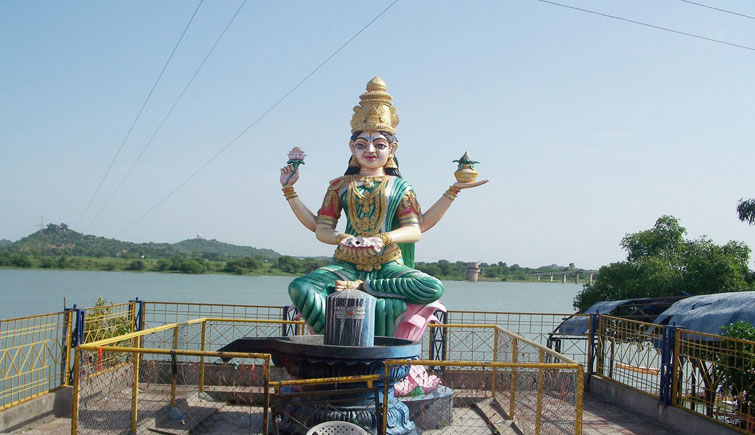
Built to honor Goddess Saraswati, this temple in Basar is one of the two famous temples in the whole of India dedicated to Goddess Saraswati, the first one located in Jammu and Kashmir. Since this Hindu deity Saraswati is considered to be the Goddess of Knowledge, many devotees bring their children to attend a ceremony called Aksharabhyasam. It is a famous South Indian ritual before the kids receive any kind of formal education.
Located in close proximity to the River Godavari, the Gnana Saraswati Temple in Basar, Telangana is an ancient temple. It is said that after Mahabharata, Sage Veda Vyasa meditated here at the Kumaranchala hills on the banks of River Godavari in search of peace, where the goddess appeared to him and told him to offer three handfuls of sand every day. It was later that these sand dunes transformed into the idol of Goddesses Saraswati, Lakshmi, and Kali. These are the idols which are worshiped at the temple even today. Numerous devotees from the region throng the temple during the festivities of Mahashivratri, Navratri, and Vasant Panchami to seek the blessings of the goddesses.
- Main Deity: Goddess Saraswati
- Place: Basar
- Highlight: Take a short pilgrimage walk up the mountain above the temple to see the Idol of Goddess Saraswati sitting on a lotus.
Karmanghat Hanuman Temple: Pay homage to the divine Lord Hanuman and the protector of Lord Ram and Sita in Hyderabad
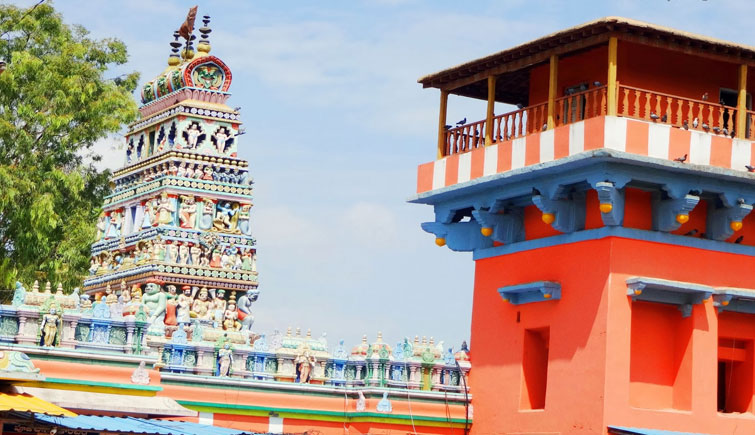
Karmanghat Hanuman Temple is probably the most popular and oldest Hanuman temple in Hyderabad. The two auspicious days of Tuesdays and Saturdays are considered most holy when you can witness many devotees gathering in this temple. One of the main festivals here is the Hanuman Jayanti that celebrates the birthday of Lord Hanuman during the months of either April or March, observed according to the Hindu calendar.
Though the presiding deity of the temple is Lord Hanuman, the temple complex also houses shrines of other gods like Lord Rama, Lord Shiva, Goddess Saraswati, Goddess Durga, Goddess Santoshimata, Lord Venugopala Swamy, and Lord Jagannath. The Karmanghat Hanuman Temple is said to have been built by a ruler from the Kakatiya Dynasty during the 12th century, after he found an idol of Lord Hanuman in a forest chanting the name of Lord Rama. It was later that he was instructed by Lord Hanuman himself in a dream to construct the temple.
- Main Deity: Lord Hanuman
- Place: Hyderabad
- Highlight: The temple organizes Annadanam that provides free food to the devotees and also to the hungry homeless.
Sri Raja Rajeshwara Temple: Purify your soul in a temple dedicated to Lord Shiva at Vemulawada
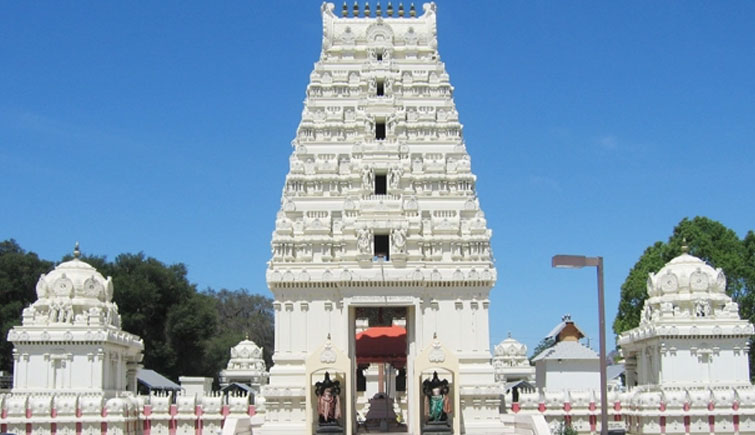
Locally known as Rajanna, this spiritual temple of Sri Raja Rajeshwara is dedicated to Lord Shiva. The main idol of Raja Rajeshwara is coupled with two important deities Sri Raja Rajeswari Devi and Sri Laxmi Sahitha Siddi Vinayaka. Being a popular Shiva temple, it draws many pilgrims throughout the year. During the festival of Maha Shivaratri, devotees receive a special offering by the temple called Kode Mokku. It is an important ritual where the devotees partake in pradakshinam around the temple with a Kode, a bull.
Located in the Vemulawada village of Karimnagar district of Telangana, the Sri Raja Rajeshwara Temple is often known as “Dakshina Kasi”, or the Kashi of the South, and “Harihara Kshetram”, for the existence of two shrines dedicated to Lord Vishnu that exist within the temple complex. Within the temple complex, there is even a dargah that displays a feeling of harmony between the two religions. In the Bhavishyottara Purana, the temple finds mention for being the place where Lord Surya prayed to rid himself of a disability, hence lending the temple another name, the Bhaskara Kshetram.
- Main Deity: Lord Shiva
- Place: Vemulawada
- Highlight: Dharma Gundam, a holy water tank is considered to have medicinal properties and the devotees are often seen taking a dip before proceeding to the main temple.
Chaya Someswara Swamy Temple: Sight the Shadowed Lingam in an 11th Century temple in Panagal Village
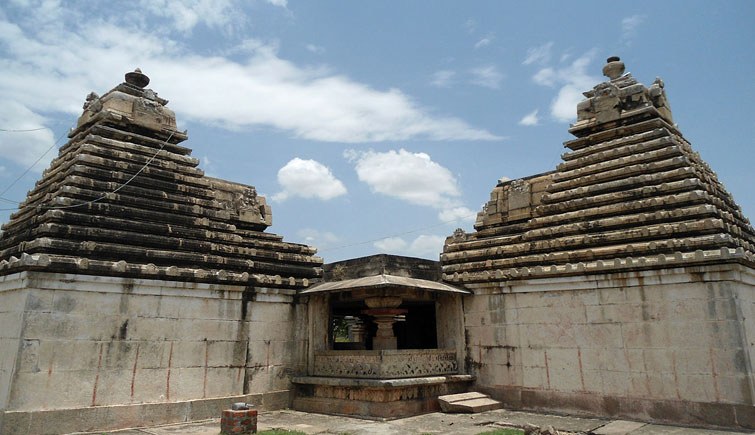
Chaya Someswara Swamy Temple, also known as Thrikutalayam was built between the 11th and the 12th centuries by the Ikshvaku family. The presiding deity at the temple is Lord Shiva whose idol is beautifully decorated during the festive night of Shivaratri. As such, it is during the festival of Shivratri that the temple sees a good amount of crowd.
It is said that the Lingam in the main temple is said to always be shadowed, thus the name Chaya in the name of the temple. The shadow that falls on the deity has been strategically built so that the light that falls on the pillars of the temple always keep the deity shadowed, making it the prominent attraction of the temple. Located in Panagal, in the Nalgona district of Telangana, the Chaya Someswara Swamy Temple was designed by the Kunduru Dynasty and is credited with the architectural prowess of the temple. The temple, apart from housing the idol of Lord Shiva, also houses the idols of Lord Brahma, and Lord Vishnu, each of them facing a different direction but joined by a common mandapa at the temple. The intricate carvings on the pillars and walls of the temple are also one of the reasons for the mesmerizing beauty that captivates devotees to come visit the temple.
- Main Deity: Lord Shiva
- Place: Panagal Village
- Highlight: Explore one of the Garbhagriha, an innermost sanctum of the temples that is in a constant shadow from dawn to dusk at the temple.
Narasimha Temple: Relish the beauty of nature and adore the unique architecture of Narasimha Temple in Nampally Gutta
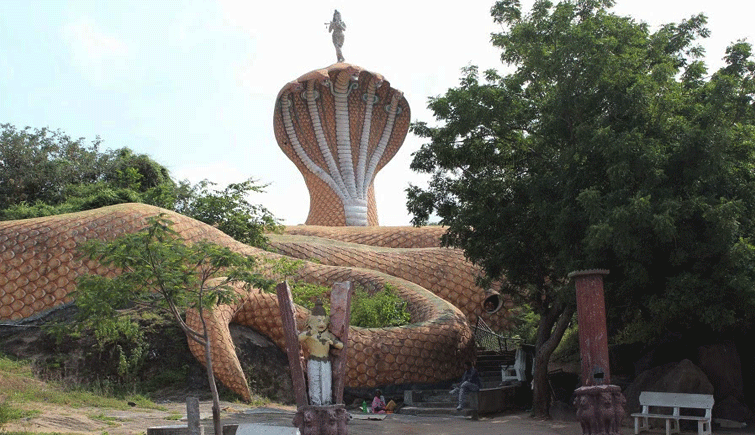
Beautifully built in the shape of a Snake, Narasimha Temple located in Nampally Gutta is one of the must-see temple attractions in Telangana. Perhaps it is the fascinating structure of the shrine itself that triggers the mind of the devotees who flock to this temple. Seated on a small hillock between the highway of Vemulawada and Karimnagar, this shrine dedicated to the reincarnated Lord Lakshmi Narasimha is one of the most fascinating temples ever built in India.
Being located on a hilltop, visiting the temple requires the devotees to climb up a few hundred steps that lead to the temple. The Narasimha Temple is dedicated to Lord Narasimha, an incarnation of Lord Vishnu, whose idol is said to have been carved out of a rock. It was later that the temple was built around the idol at the hill. Devotees coming to the temple can enter through the “belly” of the snake-shaped temple. Passing through which and entering the long tunnel, one can see many statues depicting the story of Prahalad and Hiranyakashipu, and at the end where Lord Narasimha ends up killing Hiranyakashiu.
- Main Deity: Lord Lakshmi Narasimha (incarnation of Lord Vishnu)
- Place: Nampally Gutta
- Highlight: The temple structure is the major highlight that allows the devotees to enter through the snake belly. Traversing a winding tunnel, the end of the shrine houses the idol of Lord Narasimha killing the demon Hiranyakashipu.
Temples in South India are as fascinating as their culture and the landscape. With mesmerizing architecture, unique legends, myths, and rituals, these temples will ultimately make your pilgrimage trip experience like never before. Visit some of the best destinations in South India on a pilgrimage tour to the region and witness the serenity and beauty of these religious destinations for yourself. We hope that you now have a better idea about the many pilgrimage sites of southern India and have bookmarked the temples you’d want to visit in your wishlist already.
Other interesting Blogs to Read
- Popular Must Visit Temples in North India
- Famous Durga Temples in India
- Popular Shiva Temples in India
- Most Famous Temples in India
- Popular Krishna Temples in India
Like & Follow our social media accounts at Twitter, Facebook, Linkedin & Instagram for getting the latest updates & offers on holiday packages.
Disclaimer: We do not take credit for some of the licenced paid images used in our blogs, whether from Google Images, Fotolia & Shutterstock. All such images are the copyrights of their respective owners and we try to provide credit for them wherever we can. If, however, any copyright image has been used on our blog, the concerned person can either mail us directly to remove the image or provide credit to whomsoever the image may belong to.
Published: 29 Feb, 2024
Recent Trending Posts
Category
Popular Posts
India Tourism Important Information Resources
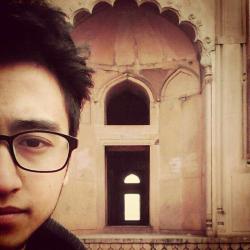



















No comments:
Post a Comment